机械制造专业英语--课后答案(部分)
- 格式:docx
- 大小:39.96 KB
- 文档页数:31
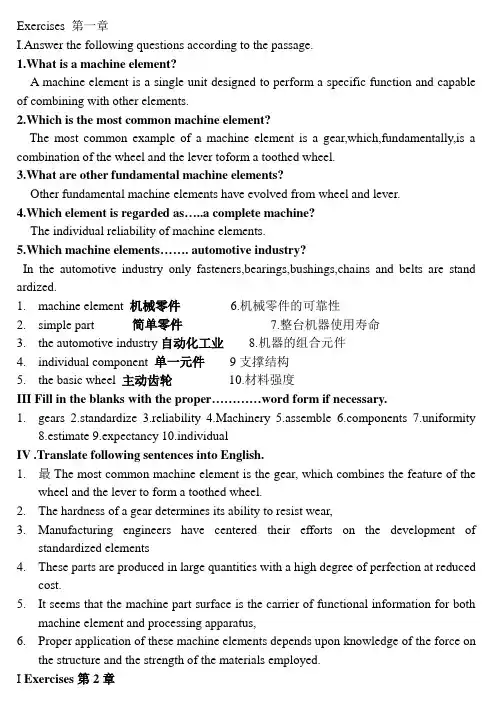
Exercises 第一章I.Answer the following questions according to the passage.1.What is a machine element?A machine element is a single unit designed to perform a specific function and capable of combining with other elements.2.Which is the most common machine element?The most common example of a machine element is a gear,which,fundamentally,is a combination of the wheel and the lever toform a toothed wheel.3.What are other fundamental machine elements?Other fundamental machine elements have evolved from wheel and lever.4.Which element is regarded as…..a complete machine?The individual reliability of machine elements.5.Which machine elements……. automotive industry?In the automotive industry only fasteners,bearings,bushings,chains and belts are stand ardized.1.machine element 机械零件 6.机械零件的可靠性2.simple part 简单零件7.整台机器使用寿命3.the automotive industry自动化工业8.机器的组合元件4.individual component 单一元件9支撑结构5.the basic wheel 主动齿轮10.材料强度III Fill in the blanks with the proper…………word form if necessary.1.gears2.standardize3.reliability4.Machinery5.assembleponents7.uniformity8.estimate 9.expectancy 10.individualIV .T ranslate following sentences into English.1.最The most common machine element is the gear, which combines the feature of thewheel and the lever to form a toothed wheel.2.The hardness of a gear determines its ability to resist wear,3.Manufacturing engineers have centered their efforts on the development ofstandardized elements4.These parts are produced in large quantities with a high degree of perfection at reducedcost.5.It seems that the machine part surface is the carrier of functional information for bothmachine element and processing apparatus,6.Proper application of these machine elements depends upon knowledge of the force onthe structure and the strength of the materials employed.1.Do you know why there are so many types of bearings?There are many types of bearings because of variations in the design of rings and separators and in the number of balls.2.For what reason are deep groove radial ball bearings mas widely used?Although deep groove ball bearings are designed to carry a radial load, they perform well under a combined radial and thrust load ,For this reason ,it is the most widely used type of ball bearing.3.According to the text,how many types can ......... be divided into?what are they? The bearings can be divided into 6 types,that is ,deep groove ball bearings ,filled -notch ball bearings,angular contact bearings,self-aligning ball bearings,thrust ball bearings and roller bearings.4.Why can roller bearings ..... higher load than the same size ball bearings? Because it has line contact instead of point contact.5.Depending onits size,after increasing..........bearing.Is it true?Y es,it is true.1.轴承承载能力—bearing load capacity 6.深沟球轴承2.径向载荷——radial load 7.角接触球轴承3.滚柱轴承——roller bearing 8 调心球轴承4.轴向载荷——thrust load 9 推力球轴承5.公共球面滚道—common spherical race 10 填充式滚球轴承III1.According to their....and a (combination)of thrust and radial loads.2.The races are........diameter in(deep groove ball)bearings.3.To increase the......bearing(load capacity).4.Unidirectional thrust ......to(support)combined ....loads.5.(seld-aligning ball).6.(higher load ).7.(the ball complement).9.revolving rings).10.line contactIV.1沟:The deep groove ball bearing is the most widely used type of ball bearing.1.多数:Many bearings require periodic maintenance to prevent premature failure.2.滚柱:Roller bearing can support much higher load than comparably sized ball bear ing.3.预期:Approximately two-thirds as many materials would be expected to produce the same effect.4.这一:This programme will require a twenty-five percent increase in processor capacity.5.一般:The surface temperature of the bearings was generally the same as what has been previously observed.I 1.What is the way of parts mating in the early days of engineering?In the early days of engineering ,the mating of parts was achieved by machining one part as nearly as possible to the required size,machining the mating part nearly to size,and then completing its machining,continually offering the other part to it,until the desired relation-ship was obtained.2.What is the advantage of interchangeability system?A system of interchangeability usually lower the production costs,as there is no meed for an xpensive "fiddling"operation,and it also benefits the customer in the event of the need to replace worn parts.3.This kind of system demands that the dimensions of mating pars be specified, and that dimensional variations,due to machine and operator shortcomings, be taken into account.4.The magnitude of the tolerance depends upon the type of operation involved,the skill of the machinist ,the accuracy of the machine,and the size of the part,5.The tolerance should be as large as possible.II 1.双边:bilateral limits 6,公差与极限尺寸2间隙:clearance fit 7可交换性系统3边:interference fit 8尺寸误差4基轴:shaft-based system 9允许的最大误差5基孔:hole-based system 10单边极限III 1.The difference between the .......called the(maximum errors permitted).2.For given grade.......must be (increased).3.(ground)4.elapsed.5.scrape.6 interchangeable. 7.specified .8.designated 9.indicated 10.specificationIV. 1.显然,:It is obvious that the two parts would have to remain together,and in the event of one having to be replaced,the fitting would have to be done all over again. 2.具有:A system of interchangeability usually lowers the production costs,as there is no need for an expensive"fiddling"operation,and it also benefits the customer in the event of the need to replace worn parts..3.必须:Some form of inspection must be introduced to ensure that the manufacture is controlled;this is particularly important,because dimensional errors may not be revealed until some time has elapsed,and often many miles from the place where the machining was done.4.这:The extreme dimensions are called the limits of size,and the difference between them is called the tolerance.5.公差:The magnitude of the tolerance depends upon the type of operation6.单边:Unilateral limits are usually used when the distance between two faces,of the diameter of diameter of a hole or shaft is specified.Exercises第4章I 1.what is the function of a mold?The function of a mod is two respects:imparting the desired shape to the elasticized polymer and cooling the injection molded part,2.What is the mold mainly made up of ?It is basically made up of two sets of components:the cavities and cores and the base in which the cavities and cores are mounted.3.Parting line4.It allows escape of trapped air and gas.II 1.分:parting line 6.定模2.主:sprue bushing 7对称(平衡)流道系统3.复:return pin 8液压油缸4.主流:primary sprue 9侧导板5.注射:injection molded part 10注射模具设计III 1.(Guide pins)can maintain.......halves of a mold.2.Mold base.3.the parting line.4.the size and weight5.a stationary molds half6.cores7.distance8.cooling9.primary sprue 10.Water channels.IV 1.塑料:The size and weight of the molded parts limit the number of cavities in the mold and also determine the machinery capacity required.2 有时:In some cases the cavity is partly in the stationary and partly in the moving sections.3.模板:Mold Base--Hold cavity(cavities)in fixed, correct position relative to machine nozzle4.Cavity (female)and Force(male)-Control size,shape and surface texture of mold article.5.Ejector Return Pins--Return ejector pins to retracted position as mold closes for next cycle.6.The distance between the outer cavities and the primary sprue must not be so long that the molten plastic loses too much heat in the runner to fill the outer cavities properly.Exercises第5章I 1.When have some.............optical fibers in communications?Since 1974The success of industry in turning such effective techniques to advantage by developing low-cost products will determine the impact which optical fibers have on communications.3.The telephone systems can be divided into three networks:the local network,which ties customers to their respective local switching offices; the trunk network, which interconnects the switching offices; the long-distance network between cities.4.When there are many telephone calls to be carried between points such as switching offices,fiber systems are economically attractive.rger fiber bandwidth, lower loss and more reliable optical sources would make optical fibers more competitive.II 1.光纤:optical fiber 6.无线光学通信2.light-wave-guide fiber 7在一对一的基础上3.中:switching office 8本地线路4.wire pair 9铜线5.Low loss 10传统通信服务III 1.The present competition (has shifted)the ........fibers.2.The telephone systems can (be divided)into three networks.3.Benefitpete 6.suggest 7.loops 8.technology pete 10wire pairs.IV 1.研究:Moreover,studies suggest that this may be the case for some tine.2.Thus the interoffice trunk network will be the first to benefit from this new technology.3.In fact, various trunk-oriented communications systems are under construction or in operation in many industrialized countries.4.Optical fibers have the advantage of small cable size and weight and immunity to lightning and other electromagnetic interference.5.A few optical fibers data link systems are already on the market,and more are under devel-opment.Exercises第6章I 1.what are advantaged of the induction motor?Simplicity, economy and durability.2.Because of their ruggedness and lower cost3.It is most useful when a high-speed drive is desired.4.Wound-rotor motor.5.Cost factor.II 1.交流:ac motor 2.induction 3.constant speed. 4.single-phase.5.continuous.III 1.鼠:Squirrel-cage induction motors are known for their ruggedness and lower cost.2.Squirrel-cage motor requires very little control equipment.3.Wound-rotor motor requires additional secondary control.4.Synchronous may be used for almost any constant-speed drive requiring about 100 hp or over.5.Synchronous motor requires a source of dc excitation and special synchronizing control.Exercises第7章I 1.What is the definition of the transducer?A transducer is a device which converts the quantity being measured into an optical,mechanical or more commonly electrical signal.2.Capacitance inductance transducers,magnetoelectric transducers,thermoelectric transducers and photoelectric transducer,etc.3.Displacement,pressure,vibration,sound and liquid level.4.Natural quartz crystals or barium titanate ceramics.5.T emperature at localized points can be determined,They are robust,with a wide operating range from -250C-2,000c.II 1.位移:displacement. 2.thermocouple. 3.resolution.4.impedance.5.photovoltaic effect. 6.磁场。
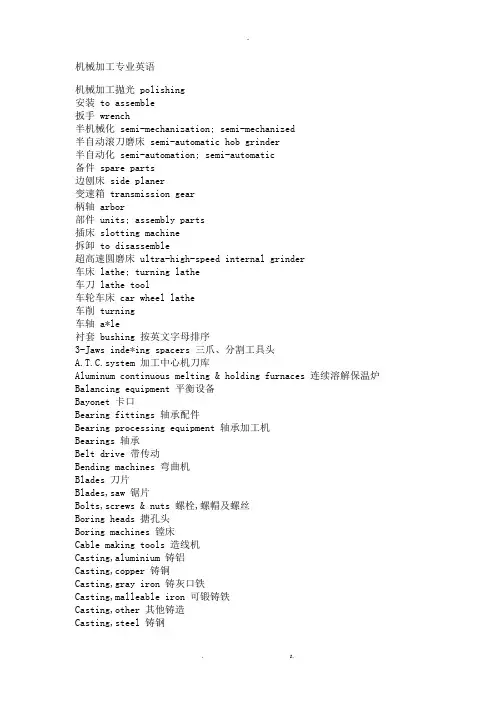
机械加工专业英语机械加工拋光 polishing安装 to assemble扳手 wrench半机械化 semi-mechanization; semi-mechanized半自动滚刀磨床 semi-automatic hob grinder半自动化 semi-automation; semi-automatic备件 spare parts边刨床 side planer变速箱 transmission gear柄轴 arbor部件 units; assembly parts插床 slotting machine拆卸 to disassemble超高速圆磨床 ultra-high-speed internal grinder车床 lathe; turning lathe车刀 lathe tool车轮车床 car wheel lathe车削 turning车轴 a*le衬套 bushing 按英文字母排序3-Jaws inde*ing spacers 三爪、分割工具头A.T.C.system 加工中心机刀库Aluminum continuous melting & holding furnaces 连续溶解保温炉Balancing equipment 平衡设备Bayonet 卡口Bearing fittings 轴承配件Bearing processing equipment 轴承加工机Bearings 轴承Belt drive 带传动Bending machines 弯曲机Blades 刀片Blades,saw 锯片Bolts,screws & nuts 螺栓,螺帽及螺丝Boring heads 搪孔头Boring machines 镗床Cable making tools 造线机Casting,aluminium 铸铝Casting,copper 铸铜Casting,gray iron 铸灰口铁Casting,malleable iron 可锻铸铁Casting,other 其他铸造Casting,steel 铸钢Chain drive 链传动Chain making tools 造链机Chamfer machines 倒角机Chucks 夹盘Clamping/holding systems 夹具/支持系统C bending presses 电脑数控弯折机C boring machines 电脑数控镗床C drilling machines 电脑数控钻床C EDM wire-cutting machines 电脑数控电火花线切削机C electric discharge machines 电脑数控电火花机C engraving machines 电脑数控雕刻机C grinding machines 电脑数控磨床C lathes 电脑数控车床C machine tool fittings 电脑数控机床配件C milling machines 电脑数控铣床C shearing machines 电脑数控剪切机C toolings C刀杆C wire-cutting machines 电脑数控线切削机Conveying chains 输送链Coolers 冷却机Coupling 联轴器Crimping tools 卷边工具Cutters 刀具Cutting-off machines 切断机Diamond cutters 钻石刀具Dicing saws 晶圆切割机Die casting dies 压铸冲模Die casting machines 压铸机Dies-progressive 连续冲模Disposable toolholder bits 舍弃式刀头Drawing machines 拔丝机Drilling machines 钻床Drilling machines bench 钻床工作台Drilling machines,high-speed 高速钻床Drilling machines,multi-spindle 多轴钻床Drilling machines,radial 摇臂钻床Drilling machines,vertical 立式钻床drills 钻头Electric discharge machines(EDM) 电火花机Electric power tools 电动刀具Engraving machines 雕刻机Engraving machines,laser 激光雕刻机Etching machines 蚀刻机Finishing machines 修整机Fi*ture 夹具Forging dies 锻模Forging,aluminium 锻铝Forging,cold 冷锻Forging,copper 铜锻Forging,other 其他锻造Forging,steel 钢锻Foundry equipment 铸造设备Gear cutting machines 齿轮切削机Gears 齿轮Gravity casting machines 重力铸造机Grinder bench 磨床工作台Grinders,thread 螺纹磨床Grinders,tools & cutters 工具磨床Grinders,ultrasonic 超声波打磨机Grinding machines 磨床Grinding machines,centerless 无心磨床Grinding machines,cylindrical 外圆磨床Grinding machines,universal万能磨床Grinding tools 磨削工具Grinding wheels 磨轮Hand tools 手工具Hard/soft and free e*pansion sheet making plant 硬(软)板(片)材及自由发泡板机组Heat preserving furnaces 保温炉Heating treatment funaces 熔热处理炉Honing machines 搪磨机Hydraulic ponents 液压元件Hydraulic power tools 液压工具Hydraulic power units 液压动力元件Hydraulic rotary cylinders 液压回转缸Jigs 钻模Lapping machines 精研机Lapping machines,centerless 无心精研机Laser cutting 激光切割Laser cutting for SMT stensil 激光钢板切割机Lathe bench 车床工作台Lathes,automatic 自动车床Lathes,heavy-duty 重型车床Lathes,high-speed 高速车床Lathes,turret 六角车床Lathes,vertical 立式车床Lubricants 润滑液Lubrication Systems 润滑系统Lubricators 注油机Machining centers,general 通用加工中心Machining centers,horizontal 卧式加工中心Machining centers,horizontal & vertical 卧式及立式加工中心Machining centers,vertical 立式加工中心Machining centers,vertical double-column type 立式双柱加工中心Magnetic tools 磁性工具Manifolds 集合管Milling heads 铣头Milling machines 铣床Milling machines,bed type 床身式铣床Milling machines,duplicating 仿形铣床Milling machines,horizontal 卧式铣床Milling machines,turret vertical 六角立式铣床Milling machines,universal 万能铣床Milling machines,vertical 立式铣床Milling machines,vertical & horizontal 立式及卧式铣床Mold & die ponents 模具单元Mold changing systems 换模系统Mold core 模芯Mold heaters/chillers 模具加热器/冷却器Mold polishing/te*turing 模具打磨/磨纹Mold repair 模具维修Molds 模具Nail making machines 造钉机Oil coolers 油冷却器Overflow cutting machines for aluminium wheels 铝轮冒口切断机P type PVC waterproof rolled sheet making plant P型PVC高分子防水PCB fine piecing systems 印刷电器板油压冲孔脱料系统Pipe & tube making machines 管筒制造机Planing machines 刨床Planing machines vertical 立式刨床Pneumatic hydraulic clamps 气油压虎钳Pneumatic power tools 气开工具Powder metallurgic forming machines 粉末冶金成型机Presses,cold forging 冷锻冲压机presses,crank 曲柄压力机Presses,eccentric 离心压力机Presses,forging 锻压机Presses,hydraulic 液压冲床Presses,knuckle joint 肘杆式压力机Presses,pneumatic 气动冲床Presses,servo 伺服冲床Presses,transfer 自动压力机Pressing dies 压模Punch formers 冲子研磨器Quick die change systems 速换模系统Quick mold change systems 快速换模系统Reverberatory furnaces 反射炉Rollers 滚筒Rolling machines 辗压机Rotary tables 转台Sawing machines 锯床Sawing machines,band 带锯床Saws,band 带锯Saws,hack 弓锯Saws,horizontal band 卧式带锯Saws,vertical band 立式带锯shafts 轴Shapers 牛头刨床Shearing machines 剪切机Sheet metal forming machines 金属板成型机Sheet metal working machines 金属板加工机Slotting machines 插床spindles 主轴Stamping parts 冲压机Straightening machines 矫直机Switches & buttons 开关及按钮Tapping machines 攻螺丝机Transmitted chains 传动链Tube bending machines 弯管机Vertical hydraulic broaching machine 立式油压拉床Vises 虎钳Vises,tool-maker 精细平口钳Wheel dressers 砂轮修整器Woven-Cutting machines 织麦激光切割机Wrenches 扳手Aabrasion n. 磨料,研磨材料,磨蚀剂, adj. 磨损的,磨蚀的abrasive belt n. 砂带abrasive belt grinding n.砂带磨削,用研磨带磨光abrasive cut-off machine n. 砂轮切断机abrasive dressing wheel n. 砂轮修整轮abrasive grain n. 磨料粒度abrasive grit n. 研磨用磨料,铁粒abrasive lapping wheel n. 磨料研磨轮accuracy of position n. 位置精度accuracy to shape n. 形状精度active cutting edge n. 主切削刃adapter flange n. 连接器法兰盘adjointing flanks n. 共轭齿廓align n. 找中(心),找正,对中,对准,找平,调直,校直,调整,调准angle milling cutter n. 角铣刀angular grinding n. 斜面磨削,斜磨法angular milling n. 斜面铣削angular plunge grinding n. 斜向切入磨削angular turning n. 斜面车削arbour n. 刀杆,心轴,柄轴,轴,辊轴attachment n. ,机构,联结,固接,联结法automatic bar machine n. 棒料自动车床automatic boring machine n. 自动镗床automatic copying lathe n. 自动仿形车床automatic double-head milling machine n. 自动双轴铣床automatic lathe n. 自动车床automatic turret lathe n. 自动转塔车床Bbelt grinding machine n. 砂带磨床bench lathe n. 台式车床bevel n. 斜角,斜面,倾斜,斜切,斜角规,万能角尺,圆锥的,倾斜的,斜边,伞齿轮,锥齿轮bevel gear cutting machine n. 锥齿轮切削机床bevel gear tooth system n. 锥齿轮系,锥齿轮传动系统borehole n. 镗孔,镗出的孔,钻眼boring n. 镗孔,钻孔,穿孔boring fi*ture n. 镗孔夹具boring machine n. 镗床boring tool n. 镗刀boring, drilling and milling machine n. 镗铣床broaching machine n.拉床,铰孔机,剥孔机broaching tool n. 拉刀broad finishing tool n. 宽刃精切刀,宽刃精车刀,宽刃光切刀CCalibrate vt. 校准〔正〕,刻度,分度,检查〔验〕,定标,标定,使标准化,使符合标准cam contour grinder n. 凸轮仿形磨床carbide tip n. 硬质合金刀片carbide turning tool n. 硬质合金车刀carbide-tipped tool n. 硬质合金刀具cast iron machining n. 铸铁加工,铸铁切削加工centerless cylindrical grinder n. 无心外圆磨床ceramic cutting tool n. 金属瓷刀具chamfer n.;vt. 倒角,倒棱chamfered cutting edge n. 倒角刀刃champ v. 焦急champing fi*ture n. 快换夹具champing jaw n. 快换卡爪chaser n. 螺纹梳刀,梳刀盘,板牙chatter vi.;n. 振动,振荡,震颤,刀振cherry n.;a. 樱桃,鲜红的,樱桃木制的chip n. 切屑,铁屑,刀片,刀头,片,薄片,芯片,基片chip breaker groove radius n. 断屑槽底半径,卷屑槽底半径chip clearance n. 切屑间隙chip cross-sectional area n. 切屑横截面面积chip curl n. 螺旋形切屑chip flow n. 切屑流chip formation n. 切屑形成chip removing process n. 去毛刺加工chip variable n.切屑变量chuck n. 卡盘,夹盘,卡头,〔电磁〕吸盘,vt. 固定,装卡,夹紧,卡住chucker n. 卡盘车床,卡角车床circular drilling machine n. 圆工作台钻床circular path n. 环路,圆轨迹circular pitch measurement n. 周节测量circumference n. 圆周,周线,周界,周围,四周,围close-grained a. 细颗粒的coffecient of tool thrust n. 刀具推力系数coil chip n. 卷状切屑cold circular saw n. 冷圆锯cold saw n. 冷锯column drilling machine n. 圆〔方〕柱立式钻床bined drill and milling cutter n. 复合钻铣床plete traverse grinding n. 横进给磨削,切入磨削puter-controlled machine n. 计算机控制机床,数控机床contact pattern n. 靠模continuous chip n. 连续切屑continuous spiral chip n. 连续螺旋切屑contour n. 轮廓,外形,外貌,轮廓线,回路,网路,电路,等高线,等值线,轮廓等高距 a. 仿形的,靠模的contour grinding n. 仿形磨削,成形磨削contour milling n. 成形铣削,外形铣削,等高走刀曲面仿形法conve* milling attachment n. 凸面铣削conve* turning attachment n. 中凸车削,凸面车削coolant lubricant n. 冷却润滑剂coolant lubricant emulsion n. 冷却润滑乳液〔剂〕copy n. 样板,仿形,靠模工作法,拷贝复制品, v. 复制,模仿,抄录copy grinding n. 仿形磨床copy-mill n. 仿形铣copying turret lathe n. 仿形转塔车床corner n. 角,弯〔管〕头,弯管counterbore n. 埋头孔,沉孔,锥口孔,平底扩孔钻,平底锪钻, n.;vt. 扩孔,锪孔,镗孔,镗阶梯孔crankshaft grinding machine n. 曲轴磨床crankshaft turning lathe n. 曲轴车床creep feed grinding n. 缓进给磨削cross milling n. 横向铣削curly chip n. 卷状切屑,螺旋形切屑,切屑螺旋cut v.;n. 切削〔割〕,口,片,断,断开,削减,减少,断面,剖面,相交,凹槽cut off n. 切断〔开,去〕,关闭,停车,停顿,断开装置,断流器,挡板,截止,截流cut teeth n. 铣齿cut-off grinding n. 砂轮截断,砂轮切割cutter n. 刀具,切削工具,截断器,切断器,切断机cutting n. 切削,切片,切割,切屑,金属屑,截槽cutting edge profile n. 切削刃轮廓〔外形,断面〕,切削刃角度cutting force n. 切削力cutting lip n. 切削刃,刀刃,钻唇,钻刃cutting operation n. 切削加工,切削操作,切削作业cutting rate n. 切削效率,切削速率cutting tool n. 刀具,切削工具,刃具cycle n. 周期,周,循环,一个操作过程,轮转,自行车cylindrical grinder n. 外圆磨床Ddamage n.;vt. 损坏〔害,伤,耗,失〕,破坏,事故,故障,伤害,危害deep-hole drilling n.深孔钻削deep-hole milling n. 深孔铣削design n. 设计,计算,方案,方案,设计书,图纸die-sinking n. 凹模dimension n. 尺寸,尺度,维度,量纲,因次direction of the feed motion n. 进给方向,进刀方向discontinuous chip n. 连续切屑distance n. 距离,间隔〔隙〕,长度,vt. 隔开double-column planer-miller n. 双柱龙门铣床dress v. 修饰,修整,平整,整理,清理,装饰,调制,准备,打磨,磨光,压平,轿直,清洗,清理,分级drilling n. 钻头,钻床,穿孔器,凿岩机,v. 钻孔,打孔,钻井,钻探drilling machine n. 钻床,钻机,钻孔机,打眼机drilling tool n. 钻孔〔削,井,眼〕工具Eedge point n. 刀口,刀刃efficiency n. 效率,效能,性能,功率,产量,实力,经济性,有〔功,实〕效end mill n. 立铣刀e*ternal grinding n. 外圆磨削Fface n. 外表,外观,工作面,表盘,屏,幕 v. 面向,朝向,外表加工,把外表弄平face grinding machine n. 平面磨床face milling machine n. 端面磨床feed force n. 进给力feed motion n. 进给运动fine adjustment n. 精调,细调,微调fine boring n. 精细镗孔finish v.;n. 精加工,抛光,修整,外表粗糙度,完工,最后加工,最后阶段,涂层,涂料finish-cutting n. 精加工,最终切削fi*ture n. 夹具,夹紧装置,配件,零件,定位器,支架form n. 型式,类型,摸板,模型,形成,产生,成形,表格 v. 形〔组,构〕成,产生,作出,成形,造型form-turn n. 成形车削free-cutting n. 自由切削,无支承切削,高速切削Ggap n. 间隔,间隙,距离,围,区间,缺口,开口火花隙, vt. 使产生裂缝 vi. 豁开gear cutting machine n. 齿轮加工机床,切齿机gear generating grinder n. 磨齿机gear hob n. 齿轮滚刀grinding cutter n. 磨具grinding force n. 磨削力grinding machine n. 磨床grinding wheel diameter n. 砂轮直径grinding wheel width n. 砂轮宽度groove n. 槽,切口,排屑槽,空心槽,坡口,vt. 切〔开,铣〕槽groove milling n.铣槽Hheadstock spindle n. 床头箱主轴,主轴箱主轴,头架轴helical tooth system n. 螺旋齿轮传动装置high precision lathe n. 高精度车床high-speed n. 高速high-speed machining n. 高速加工hob n. 齿轮滚刀,滚刀,螺旋铣刀,v. 滚铣,滚齿,滚削horsepower n. 马力hobbing machine n. 滚齿机,螺旋铣床,挤压制模压力机,反响阴模机hole n. 孔,洞,坑,槽,空穴,孔道,管道,v. 钻〔穿,冲,开〕孔,打洞hone n. vt. 磨石,油石,珩磨头,磨孔器,珩磨,honing machine n. 珩磨机,珩床,搪磨床,磨孔机,磨气缸机Iinclination n. 倾斜,斜度,倾角,斜角〔坡〕,弯曲,偏〔差,角〕转increment n. 增量,增加,增〔大〕长inde*ing table automatic n. 自动分度工作台infeed grinding n. 切入式磨削installation n. 装置,设备,台,站,安装,设置internal grinding n. 圆磨削involute hob n. 渐开线滚刀Jjig boring machine n. 坐标镗床Kkeyway cutting n. 键槽切削加工knurling tool n. 滚花刀具,压花刀具,滚花刀Llaedscrew machine n. 丝杠加工机床lap grinding n. 研磨lapping n. 研磨,抛光,精研,搭接,擦准lathe n. 车床lathe dog n. 车床轧头,卡箍,鸡心夹头,离心夹头,制动爪,车床挡块lathe tool n. 车刀level n. 水平,水准,水平线,水平仪,水准仪,电平,能级,程度,强度,a. 水平的,相等的,均匀的,平稳的loading time n. 装载料时间,荷重时间,充填时间,充气时间lock n. 锁,栓,闸,闭锁装置,锁型,同步,牵引,v. 闭锁,关闭,卡住,固定,定位,制动刹住longitudinal grinding n. 纵磨low capacity machine n. 小功率机床〔机器〕Mmachine a*is n. 机床中心线machine table n. 机床工作台machine tool n. 机床,工作母机machining n. 机械加工,切削加工machining (or cutting) variable n. 加工〔或切削〕变量machining allowance n. 机械加工余量machining cycle n. 加工循环machining of metals n. 金属切削加工,金属加工magazine automatic n. 自动化仓库,自动化料斗,自动存贮送料装置manufacture n. 制造者,生产者,厂商,产品,制造material removing rate n. 材料去除率metal cutting n. 金属切削metal-cutting technology n. 金属切削工艺学,金属切削工艺〔技术〕metal-cutting tool n. 金属切削刀具,金属切削工具micrometer adjustment n. 微调milling n. 铣削,磨碎,磨整,选矿milling feed n. 铣削进给,铣削走刀量,铣削走刀机构milling machine n. 铣床milling spindle n. 铣床主轴milling tool n. 铣削刀具,铣削工具mount v. 固定,安装,装配,装置,架设,n. 固定件,支架,座,装置,机构mounting n. 安装,装配,固定,机架,框架,装置mounting fi*ture n. 安装夹具,固定夹具NNose n. 鼻子,端,前端,凸头,刀尖,机头,突出局部,伸出局部number of revolutions n. 转数numerical control n. 数字控制numerically controlled lathe n. 数控车床Ooblique grinding n. 斜切式磨床operate v. 操纵,控制,运行,工作,动作,运算operating cycle n. 工作循环operation n. 运转,操作,控制,工作,作业,运算,计算operational instruction n. 操作说明书,操作说明operational safety n. 操作平安性,使用可靠性oscillating type abrasive cutting machine n. 摆动式砂轮切割机oscillation n. 振动,振荡,摆动,颤振,振幅out-cut milling n. 切口铣削o*ide ceramics n. 氧化物瓷o*ide-ceramic cutting tool n. 瓷刀具Pperformance n. 实行,执行,完成,特性,性能,成品,制作品,行为,动作,生产率,效率peripheral grinding n. 圆周磨削peripheral speed n. 圆周速度,周速,边缘速度perpendicular a. 垂直的,正交的,成直角的 n. 垂直,正交,竖直,垂线,垂直面physical entity n. 实体,实物pitch n. 齿距,节距,铆间距,螺距,极距,辊距,坡度,高跨比,俯仰角pitch circle n. 节圆plain (or cylindrical) milling machine n. 普通〔或圆柱形〕铣床plain grinding n. 平面磨削plain turning n. 平面车床plane n. 平面,面,投影,刨,水平,程度,阶段,飞机 a.平的 v. 弄平,整平,刨,飞行plane milling n. 平面铣削plane-mill n. 平面铣刀,平面铣床plunge mill n. 模向进给滚轧机plunge-cut n. 切入式磨削,横向进给磨削,全面进刀法,全面进给法plunge-cut thread grinder n. 切入式螺纹磨床plunge-grinding n. 切入式磨削point n. 点,尖端,刀尖,针尖,指针,交点,要点,论点,特点 v. 指,面向,瞄准,对准,说明,弄尖,强调power n. 功率,效率,能〔容,力〕量,动力,电源,能源 v. 驱〔拖,带,发〕动,给...以动力power hacksaw n. 机动弓锯〔钢锯〕precision boring n. 精镗precision boring machine n. 精细镗床precision machining n. 精细机械加工pressure angle n. 压力角primary cutting edge n. 主切削刃principal feed motion n. 主进给运动,主进刀运动production method s n. 生产方法[式]profile n. 轮廓,形面,剖面,侧面图,分布图。
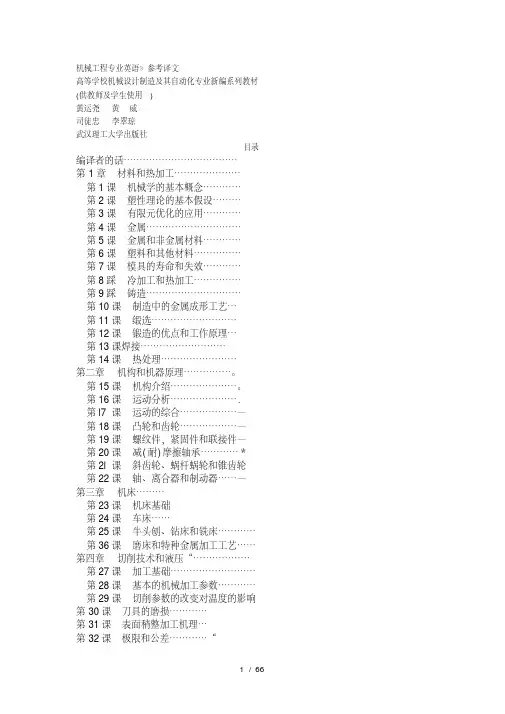
机械工程专业英语》参考译文高等学校机械设计制造及其自动化专业新编系列教材(供教师及学生使用)黄运尧黄威司徒忠李翠琼武汉理工大学出版社目录编译者的话………………………………第1章材料和热加工…………………第1课机械学的基本概念…………第2课塑性理论的基本假设………第3课有限元优化的应用…………第4课金属…………………………第5课金属和非金属材料…………第6课塑料和其他材料……………第7课模具的寿命和失效…………第8踩冷加工和热加工……………第9踩铸造…………………………第10课制造中的金属成形工艺…第11课缎选………………………第12课锻造的优点和工作原理…第13课焊接………………………第14课热处理……………………第二章机构和机器原理……………。
第15课机构介绍…………………。
第16课运动分析………………….第l7课运动的综合………………—第18课凸轮和齿轮………………—第19课螺纹件,紧固件和联接件—第20课减(耐)摩擦轴承…………*第2l课斜齿轮、蜗杆蜗轮和锥齿轮第22课轴、离合器和制动器……—第三章机床………第23课机床基础第24课车床……第25课牛头刨、钻床和铣床…………第36课磨床和特种金属加工工艺……第四章切削技术和液压“………………第27课加工基础………………………第28课基本的机械加工参数…………第29课切削参数的改变对温度的影响第30课刀具的磨损…………第31课表面稍整加工机理…第32课极限和公差…………“第33课尺寸控制和表面桔整”第34课自动央具设计………“第36课变速液压装置……………—…………—策37课电液伺服系统…………。
……………。
第五章机械电子技术………………………………第38课专家系统……。
…………………………第3D课建筑机器人………………………………第40课微机为基础的机器人模拟………………第41课机器人学的定义和机器入系统…………第42课微型计算机基础(1)……………………第43课微型计算机基础(x)……………………第44课可编程控制器……………………………第45课CAD/CAM计算机辅助设计与制造…第46课计算机数控和直接数控,CNC和DNC第47课加工过程的数控—………………………第48课柔性制造系统……………—……………第仍课交互式编程系统…………………………第50课在振动分析方面的计算机技术…………策51课压力传感器………………………………第52课反馈元件…………………—……………第53课现代按制理论概述………………………第54课管理上采取了新的措施—来自福持汽第六章英文科技文献和专利文献的查阅…………6.1 常见科技文献及其查阅………………………6.2 专利文献概述…………………………………第七章英文科拉论文写作…………………………7.1 标题与摘要写法………………………………7.2 正文(body)的组织与写法…………………7.3 致谢、附录及参考文献………………—……参考文献………………………………………………第1章材料和热加工机械学的基本概念功是力乘以该力作用在物体上佼物体移动的距离。
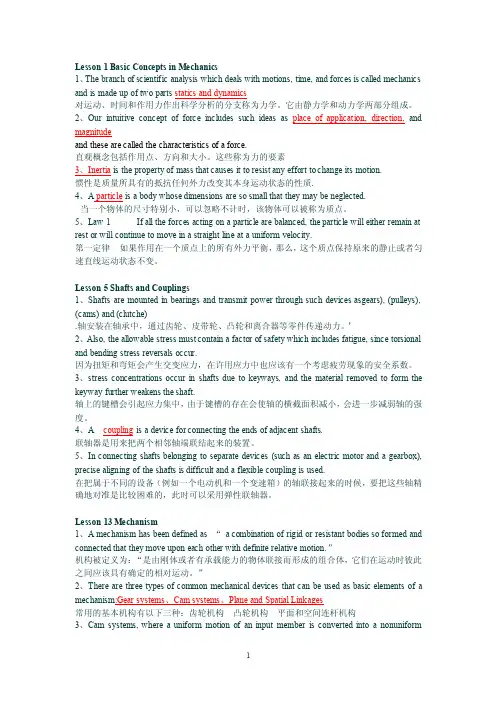
Lesson 1 Basic Concepts in Mechanics1、The branch of scientific analysis which deals with motions, time, and forces is called mechanics and is made up of two parts statics and dynamics对运动、时间和作用力作出科学分析的分支称为力学。
它由静力学和动力学两部分组成。
2、Our intuitive concept of force includes such ideas as place of application, direction,and magnitudeand these are called the characteristics of a force.直观概念包括作用点、方向和大小。
这些称为力的要素3、Inertia is the property of mass that causes it to resist any effort to change its motion.惯性是质量所具有的抵抗任何外力改变其本身运动状态的性质.4、A particle is a body whose dimensions are so small that they may be neglected.当一个物体的尺寸特别小,可以忽略不计时,该物体可以被称为质点。
5、Law 1 If all the forces acting on a particle are balanced, the particle will either remain at rest or will continue to move in a straight line at a uniform velocity.第一定律如果作用在一个质点上的所有外力平衡,那么,这个质点保持原来的静止或者匀速直线运动状态不变。
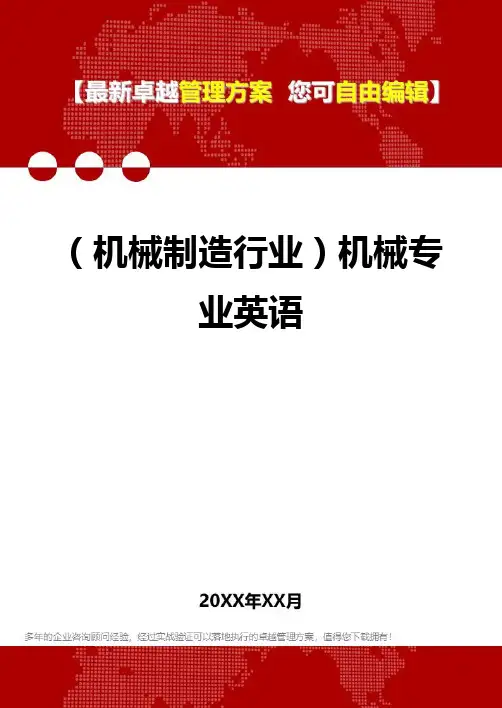
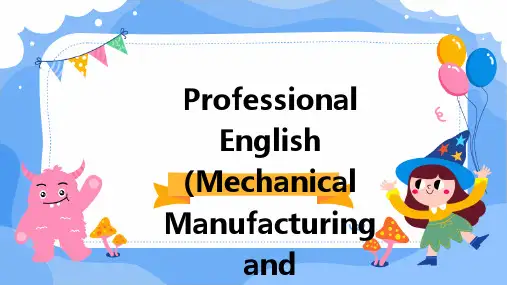
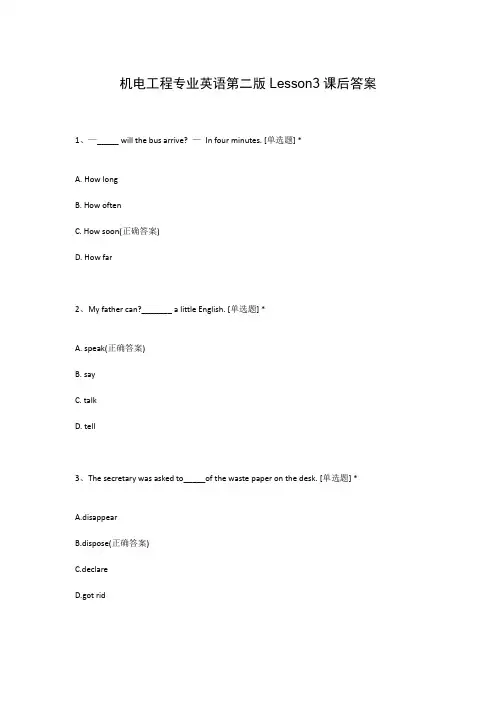
机电工程专业英语第二版Lesson3课后答案1、—_____ will the bus arrive? —In four minutes. [单选题] *A. How longB. How oftenC. How soon(正确答案)D. How far2、My father can?_______ a little English. [单选题] *A. speak(正确答案)B. sayC. talkD. tell3、The secretary was asked to_____of the waste paper on the desk. [单选题] *A.disappearB.dispose(正确答案)C.declareD.got rid4、—Look at those purple gloves! Are they ______, Mary?—No, they aren’t. ______ are pink. ()[单选题] *A. you; IB. your; MyC. yours; Mine(正确答案)D. you; Me5、The Chinese team are working hard _______ honors in the Olympic Games. [单选题] *A. to win(正确答案)B. winC. winningD. won6、We should _______ a hotel before we travel. [单选题] *A. book(正确答案)B. liveC. stayD. have7、Tony can _______ the guitar.Now he _______ the guitar. [单选题] *A. play; plays(正确答案)B. playing; playingC. plays; is playingD. play; is playing8、My father always gets up early. He’s never late _______ work. [单选题] *A. toB. for(正确答案)C. onD. at9、8.Turn right ________ Danba Road and walk ________ the road, then you will findMeilong Middle school. [单选题] *A.in...alongB.into...along (正确答案)C.in...onD.into...on10、_________ we don't stop climate change, many animals and plants in the world will be gone. [单选题] *A.AlthoughB.WhileC.If(正确答案)D.Until11、I've never been to Africa, but that is the place(). [单选题] *A. where I most want to visitB. in which I most want to visitC. I most want to visit(正确答案)D. that I want to visit it most12、17.—When ________ they leave here?—Tomorrow morning. [单选题] * A.doB.will(正确答案)C.doesD.are13、Mr. White likes to live in a _______ place. [单选题] *A. quiteB. quiet(正确答案)C. quickD. quietly14、()of the twins was arrested because I saw them both at a party last night. [单选题] *A. NoneB. BothC. Neither(正确答案)D. All15、If you had told me earlier, I _____ to meet you at the hotel. [单选题] *A. had comeB. will have comeC. would comeD. would have come(正确答案)16、Medicines are to be taken according to the doctor’s advice. [单选题] *A. 发放B. 提取C. 配方D. 服用(正确答案)17、I_____you that I had made the right decision. [单选题] *A.ensuredB.insuredC.assured(正确答案)D.for sure18、It was difficult to guess what her_____to the news would be. [单选题] *A.impressionmentC.reaction(正确答案)D.opinion19、_____you may do, you must do it well. [单选题] *A.WhichB.WheneverC.Whatever(正确答案)D.When20、You must pay more attention to your pronunciation. [单选题] *A. 词汇B. 拼写C. 发音(正确答案)D. 语法21、Taking the subway is quite fast and cheap. It can _______ both time and money. [单选题] *A. savesB. save(正确答案)C. earnD. use22、Growing vegetables()constantly watering. [单选题] *A. neededB. are neededC. were neededD. needs(正确答案)23、I used to take ____ long way to take the bus that went by ____ tunnel under the water. [单选题] *A. a, aB. a. theC. a, /(正确答案)D. the, a24、79.–Great party, Yes? ---Oh, Jimmy. It’s you!(C), we last met more than 30 years ago. [单选题] *A. What’s moreB. That’s to sayC. Believe it or not (正确答案)D. In other words25、Wang Dong usually gets up at 6:00 _______ he can catch the early school bus. [单选题] *A. as ifB. so that(正确答案)C. untilD. after26、As for the quality of this model of color TV sets, the ones made in Chine are by no means _____ those imported. [单选题] *A inferior thanB less inferior toC less inferior thanD. inferior to(正确答案)27、_____ to wait for hours,she brought along a book to read. [单选题] *A. ExpectedB. Expecting(正确答案)C. ExpectsD. To expect28、87.—Could you? ? ? ? ? ? me the way to the nearest hospital?—Sure. [单选题] * A.askB.tell(正确答案)C.talkD.speak29、( ) --------Please take my seat here.-------- __________________________. [单选题]*A. That is nice of you(正确答案)B. I think it is my seatC. No, you sit hereD. I don’t think it’s a good seat.30、Generally speaking, it is _______ to ask a woman’s age in western countries. [单选题] *A. possibleB. importantC. not polite(正确答案)D. polite。
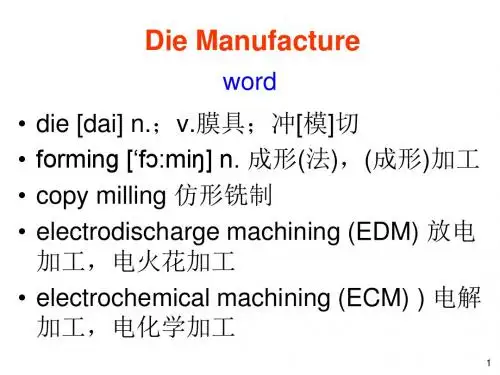
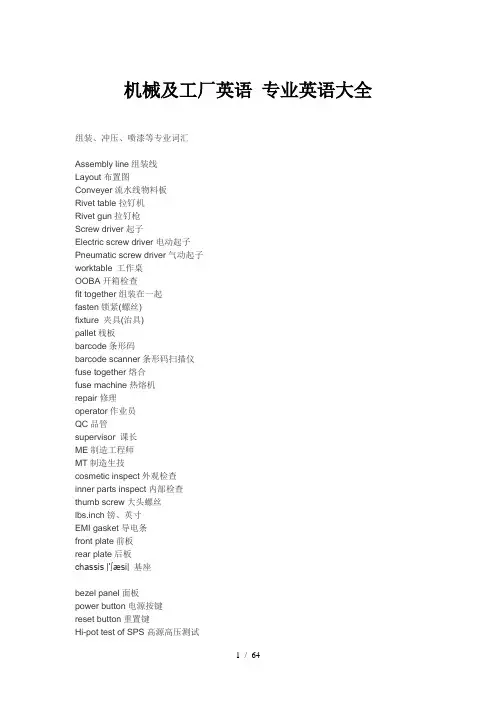
机械及工厂英语专业英语大全组装、冲压、喷漆等专业词汇Assembly line组装线Layout布置图Conveyer流水线物料板Rivet table拉钉机Rivet gun拉钉枪Screw driver起子Electric screw driver电动起子Pneumatic screw driver气动起子worktable 工作桌OOBA开箱检查fit together组装在一起fasten锁紧(螺丝)fixture 夹具(治具)pallet栈板barcode条形码barcode scanner条形码扫描仪fuse together熔合fuse machine热熔机repair修理operator作业员QC品管supervisor 课长ME制造工程师MT制造生技cosmetic inspect外观检查inner parts inspect内部检查thumb screw大头螺丝lbs.inch镑、英寸EMI gasket导电条front plate前板rear plate后板chassis |'∫æsi| 基座bezel panel面板power button电源按键reset button重置键Hi-pot test of SPS高源高压测试Voltage switch of SPS电源电压接柆键sheet metal parts 冲件plastic parts塑料件SOP制造作业程序material check list物料检查表work cell工作间trolley台车carton纸箱sub-line支线left fork叉车personnel resource department人力资源部production department生产部门planning department企划部QC Section品管科stamping factory冲压厂painting factory烤漆厂molding factory成型厂common equipment常用设备uncoiler and straightener整平机punching machine 冲床robot机械手hydraulic machine油压机lathe车床|刨床 planer |'pleinmiller铣床grinder磨床driller钻床linear cutting线切割electrical sparkle电火花welder电焊机staker=reviting machine铆合机position职务president董事长general manager总经理special assistant manager特助factory director厂长department director部长deputy manager |'depjuti| =vice manager副理section supervisor课长deputy section supervisor =vice section superisor副课长group leader/supervisor组长line supervisor线长assistant manager助理to move, to carry, to handle搬运be put in storage入库pack packing包装to apply oil擦油to file burr 锉毛刺final inspection终检to connect material接料to reverse material 翻料wet station沾湿台Tiana天那水cleaning cloth抹布to load material上料to unload material卸料to return material/stock to退料scraped |'skræpid|报废scrape ..v.刮;削deficient purchase来料不良manufacture procedure制程deficient manufacturing procedure制程不良n|氧化↔oxidation |' ksi'deiscratch刮伤dents压痕defective upsiding down抽芽不良defective to staking铆合不良mp|镶块∧embeded lump|in'bed| |lfeeding is not in place送料不到位stamping-missing漏冲production capacity生产力education and training教育及训练proposal improvement提案改善spare parts=buffer备件forklift叉车trailer=long vehicle拖板车compound die合模die locker锁模器pressure plate=plate pinch压板bolt螺栓name of a department部门名称administration/general affairs dept总务部automatic screwdriver电动启子thickness gauge厚薄规gauge(or jig)治具power wire电源线buzzle蜂鸣器defective product label不良标签identifying sheet list标示单screwdriver holder起子插座pedal踩踏板stopper阻挡器flow board流水板hydraulic handjack油压板车forklift叉车pallet栈板glove(s)手套glove(s) with exposed fingers割手套thumb大拇指forefinger食指midfinger中指ring finger无名指little finger小指band-aid创可贴iudustrial alcohol工业酒精alcohol container沾湿台head of screwdriver起子头sweeper扫把mop拖把vaccum cleaner吸尘器rag 抹布garbage container灰箕garbage can垃圾箱garbage bag垃圾袋chain链条jack升降机production line流水线chain链条槽magnetizer加磁器lamp holder灯架to mop the floor拖地to clean the floor扫地to clean a table擦桌子air pipe 气管packaging tool打包机packaging打包missing part漏件wrong part错件excessive defects过多缺陷critical defect极严重缺陷major defect主要缺陷minor defect次要缺陷not up to standard不合规格dimension/size is a little bigger尺寸偏大(小) cosmetic defect外观不良slipped screwhead/slippery screw head螺丝滑头slipped screwhead/shippery screw thread滑手speckle斑点mildewed=moldy=mouldy发霉rust生锈deformation变形burr(金属)flash(塑件)毛边poor staking铆合不良excesssive gap间隙过大grease/oil stains油污inclusion杂质painting peel off脏污shrinking/shrinkage缩水mixed color杂色scratch划伤poor processing 制程不良poor incoming part事件不良fold of pakaging belt打包带折皱painting make-up补漆discoloration羿色water spots水渍polishing/surface processing表面处理exposed metal/bare metal金属裸露lack of painting烤漆不到位safety安全quality品质delivery deadline交货期cost成本engineering工程die repair模修enterprise plan = enterprise expansion projects企划QC品管die worker模工production, to produce生产equipment设备to start a press开机stop/switch off a press关机classification整理regulation整顿cleanness清扫conservation清洁culture教养qualified products, up-to-grade products良品defective products, not up-to-grade products不良品waste废料board看板feeder送料机sliding rack滑料架defective product box不良品箱die change 换模to fix a die装模to take apart a die拆模to repair a die修模packing material包材basket蝴蝶竺plastic basket胶筐isolating plate baffle plate; barricade隔板carton box纸箱to pull and stretch拉深to put material in place, to cut material, to input落料to impose lines压线to compress, compressing压缩character die字模to feed, feeding送料transportation运输(be)qualfied, up to grade合格not up to grade, not qualified不合格material change, stock change材料变更feature change 特性变更evaluation评估prepare for, make preparations for 准备parameters参数rotating speed, revolution转速manufacture management制造管理abnormal handling异常处理production unit生产单位lots of production生产批量steel plate钢板roll material卷料manufacture procedure制程operation procedure作业流程to revise, modify修订to switch over to, switch---to throw--over switching over切换engineering, project difficulty工程瓶颈stage die工程模automation自动化to stake, staking, reviting铆合add lubricating oil加润滑油shut die架模shut height of a die架模高度analog-mode device类模器die lifter举模器argon welding氩焊vocabulary for stamping冲压常词汇stamping, press冲压punch press, dieing out press冲床uncoiler & strainghtener整平机feeder送料机rack, shelf, stack料架cylinder油缸robot机械手taker取料机conveyer belt输送带transmission rack输送架top stop上死点bottom stop下死点one stroke一行程inch寸动to continue, cont.连动to grip(material)吸料location lump, locating piece, block stop 定位块reset复位smoothly顺利dent压痕scratch刮伤deformation变形filings铁削to draw holes抽孔inquiry, search for查寻to stock, storage, in stock库存receive领取approval examine and verify审核processing, to process加工delivery, to deliver 交货to return delivery to. to send delivery back to return of goods退货registration登记registration card登记卡to control管制to put forward and hand in提报safe stock安全库存acceptance = receive验收to notice通知application form for purchase请购单consume, consumption消耗to fill in填写abrasion磨损reverse angle = chamfer倒角character die字模to collect, to gather收集failure, trouble故障statistics统计demand and supply需求career card履历卡to take apart a die卸下模具to load a die装上模具to tight a bolt拧紧螺栓to looser a bolt拧松螺栓to move away a die plate移走模板easily damaged parts易损件standard parts标准件breaking.(be)broken,(be)cracked 断裂to lubricate润滑common vocabulary for die engineering模具工程常用词汇die 模具figure file, chart file图档cutting die, blanking die冲裁模progressive die, follow (-on)die连续模compound die复合模punched hole冲孔panel board镶块to cut edges=side cut=side scrap切边to bending折弯to pull, to stretch拉伸Line stretching, line pulling线拉伸engraving, to engrave刻印up siding down edges翻边to stake铆合designing, to design设计design modification设计变化die block模块folded block折弯块sliding block滑块location pin定位销lifting pin顶料销die plate, front board模板padding block垫块stepping bar垫条upper die base上模座lower die base下模座upper supporting blank上承板upper padding plate blank上垫板spare dies模具备品spring 弹簧bolt螺栓document folder活页夹file folder资料夹to put file in order整理资料spare tools location手工备品仓first count初盘人first check初盘复棹人second count 复盘人second check复盘复核人equipment设备waste materials废料work in progress product在制品casing = containerization装箱quantity of physical inventory second count 复盘点数量quantity of customs count会计师盘,点数量the first page第一联filed by accounting department for reference会计部存查end-user/using unit(department)使用单位summary of year-end physical inventory bills年终盘点截止单据汇总表bill name单据名称This sheet and physical inventory list will be sent to accounting department together (Those of NHK will be sent to financial department)本表请及盘点清册一起送会计部-(NHK厂区送财会部)Application status records of year-end physical inventory List and physical inventory card 年终盘点卡及清册使用-状况明细表blank and waste sheet NO.空白及作废单号plate电镀mold成型material for engineering mold testing工程试模材料not included in physical inventory不列入盘点sample样品incoming material to be inspected进货待验description品名steel/rolled steel钢材material statistics sheet物料统计明细表meeting minutes会议记录meeting type 会别distribution department分发单位location地点chairman主席present members出席人员subject主题conclusion结论decision items决议事项responsible department负责单位pre-fixed finishing date预定完成日approved by / checked by / prepared by核准/审核/承办PCE assembly production schedule sheetPCE组装厂生产排配表model机钟work order工令revision版次remark备注production control confirmation生产确认checked by初审approved by核准department部门stock age analysis sheet库存货龄分析表on-hand inventory现有库存available material良品可使用obsolete material良品已呆滞to be inspected or reworked待验或重工total合计cause description原因说明part number/ P/N 料号type形态item/group/class类别quality品质prepared by制表notes说明year-end physical inventory difference analysis sheet年终盘点差异分析表physical inventory盘点数量physical count quantity账面数量difference quantity差异量cause analysis原因分析raw materials原料materials物料finished product成品semi-finished product半成品packing materials包材good product/accepted goods/ accepted parts/good parts良品defective product/non-good parts不良品disposed goods处理品warehouse/hub仓库on way location在途仓oversea location海外仓spare parts physical inventory list备品盘点清单spare molds location模具备品仓skid/pallet栈板tox machine自铆机wire EDM线割EDM放电机coil stock卷料sheet stock片料tolerance工差score=groove压线cam block滑块pilot导正筒trim剪外边pierce剪内边drag form压锻差pocket for the punch head挂钩槽slug hole废料孔feature die公母模expansion dwg展开图radius半径shim(wedge)楔子torch-flame cut火焰切割set screw止付螺丝form block折刀stop pin定位销round pierce punch=die button圆冲子shape punch=die insert异形子stock locater block定位块under cut=scrap chopper清角active plate活动板baffle plate挡块cover plate盖板male die公模female die母模groove punch压线冲子air-cushion eject-rod气垫顶杆spring-box eject-plate弹簧箱顶板bushing block衬套insert 入块club car高尔夫球车capability能力parameter参数factor系数phosphate皮膜化成viscosity涂料粘度alkali dipping脱脂main manifold主集流脉bezel斜视规blanking穿落模dejecting顶固模demagnetization去磁;消磁high-speed transmission高速传递heat dissipation热传rack上料degrease脱脂rinse水洗alkaline etch龄咬desmut剥黑膜D.I. rinse纯水次Chromate铬酸处理Anodize阳性处理seal封孔revision版次part number/P/N料号good products良品scraped products报放心品defective products不良品finished products成品disposed products处理品barcode条形码flow chart流程窗体assembly组装stamping冲压molding成型spare parts=buffer备品coordinate坐标dismantle the die折模auxiliary fuction辅助功能poly-line多义线heater band 加热片thermocouple热电偶sand blasting喷沙grit 砂砾derusting machine除锈机degate打浇口dryer烘干机induction感应induction light感应光response=reaction=interaction感应ram连杆edge finder巡边器concave凸convex凹short射料不足nick缺口speck瑕疪shine亮班splay 银纹gas mark焦痕delamination起鳞cold slug冷块blush 导色gouge沟槽;凿槽satin texture段面咬花witness line证示线patent专利grit沙砾granule=peuet=grain细粒grit maker抽粒机cushion缓冲magnalium镁铝合金magnesium镁金metal plate钣金lathe车mill锉plane刨grind磨drill铝boring镗blinster气泡fillet镶;嵌边through-hole form通孔形式voller pin formality滚针形式cam driver铡楔shank摸柄crank shaft曲柄轴augular offset角度偏差velocity速度production tempo生产进度现状torque扭矩spline=the multiple keys花键quenching淬火tempering回火annealing退火carbonization碳化alloy合金tungsten high speed steel钨高速moly high speed steel钼高速organic solvent有机溶剂bracket小磁导liaison联络单volatile挥发性resistance电阻ion离子titrator滴定仪beacon警示灯coolant冷却液crusher破碎机模具工程类plain die简易模pierce die冲孔模forming die成型模progressive die连续模gang dies复合模shearing die剪边模riveting die铆合模pierce冲孔forming成型(抽凸,冲凸)draw hole抽孔bending折弯trim切边emboss凸点dome凸圆semi-shearing半剪stamp mark冲记号deburr or coin压毛边punch riveting冲压铆合side stretch侧冲压平reel stretch卷圆压平groove压线blanking下料stamp letter冲字(料号)shearing剪断tick-mark nearside正面压印tick-mark farside反面压印冲压名称类extension dwg展开图procedure dwg工程图die structure dwg模具结构图material材质material thickness料片厚度factor系数upward向上downward向下press specification冲床规格die height range适用模高die height闭模高度burr毛边gap间隙weight重量total wt.总重量punch wt.上模重量五金零件类inner guiding post内导柱inner hexagon screw内六角螺钉dowel pin固定销coil spring弹簧lifter pin顶料销eq-height sleeves=spool等高套筒pin销lifter guide pin浮升导料销guide pin导正销wire spring圆线弹簧outer guiding post外导柱stop screw止付螺丝located pin定位销outer bush外导套模板类top plate上托板(顶板)top block上垫脚punch set上模座punch pad上垫板punch holder上夹板stripper pad脱料背板up stripper上脱料板male die公模(凸模)feature die公母模female die母模(凹模)upper plate上模板lower plate下模板die pad下垫板die holder下夹板die set下模座bottom block下垫脚bottom plate下托板(底板) stripping plate内外打(脱料板) outer stripper外脱料板inner stripper内脱料板lower stripper下脱料板零件类punch冲头insert入块(嵌入件) deburring punch压毛边冲子groove punch压线冲子stamped punch字模冲子round punch圆冲子special shape punch异形冲子bending block折刀roller滚轴baffle plate挡块located block定位块supporting block for location 定位支承块air cushion plate气垫板air-cushion eject-rod气垫顶杆trimming punch切边冲子stiffening rib punch = stinger 加强筋冲子ribbon punch压筋冲子reel-stretch punch卷圆压平冲子guide plate定位板sliding block滑块sliding dowel block滑块固定块active plate活动板lower sliding plate下滑块板upper holder block上压块upper mid plate上中间板spring box弹簧箱spring-box eject-rod弹簧箱顶杆spring-box eject-plate弹簧箱顶板bushing bolck衬套cover plate盖板guide pad导料块塑件&模具相关英文compre sion molding压缩成型flash mold溢流式模具plsitive mold挤压式模具split mold分割式模具cavity型控母模core模心公模taper锥拔leather cloak仿皮革shiver饰纹flow mark流痕welding mark溶合痕post screw insert螺纹套筒埋值self tapping screw自攻螺丝striper plate脱料板piston活塞cylinder汽缸套chip细碎物handle mold手持式模具移转成型用模具encapsulation molding低压封装成型射出成型用模具two plate两极式(模具)well type蓄料井insulated runner绝缘浇道方式hot runner热浇道runner plat浇道模块valve gate阀门浇口band heater环带状电热器spindle阀针spear head刨尖头slag well冷料井cold slag冷料渣air vent排气道h=0.02~0.05mmw=3.2mmL=3~5mmwelding line熔合痕eject pin顶出针knock pin顶出销return pin回位销反顶针sleave套筒stripper plate脱料板insert core放置入子runner stripper plate浇道脱料板guide pin导销eject rod (bar)(成型机)顶业捧subzero深冷处理three plate三极式模具runner system浇道系统stress crack应力电裂orientation定向sprue gate射料浇口,直浇口nozzle射嘴sprue lock pin料头钩销(拉料杆) slag well冷料井side gate侧浇口edge gate侧缘浇口tab gate搭接浇口film gate薄膜浇口flash gate闸门浇口slit gate缝隙浇口fan gate扇形浇口dish gate因盘形浇口H=F=1/2t~1/5tT=2.5~3.5mmdiaphragm gate隔膜浇口ring gate环形浇口subarine gate潜入式浇口tunnel gate隧道式浇口pin gate针点浇口Φ0.8~1.0mmRunner less无浇道(sprue less)无射料管方式long nozzle延长喷嘴方式sprue浇口;溶渣品质人员名称类QC quality control 品质管理人员FQC final quality control 终点质量管理人员IPQC in process quality control 制程中质量管理人员OQC output quality control 最终出货质量管理人员IQC incoming quality control 进料质量管理人员TQC total quality control 全面质量管理POC passage quality control 段检人员QA quality assurance 质量保证人员OQA output quality assurance 出货质量保证人员QE quality engineering 品质工程人员品质保证类FAI first article inspection 新品首件检查FAA first article assurance 首件确认TVR tool verification report 模具确认报告3B 3B 模具正式投产前确认CP capability index 能力指数CPK capability index of process 模具制程能力参数SSQA standardized supplier quality 合格供货商品质评估OOBA out of box audit 开箱检查QFD quality function deployment 品质机能展开FMEA failure model effectiveness analysis 失效模式分析8 disciplines 8项回复内容FA final audit 最后一次稽核CAR corrective action request 改正行动要求corrective action report 改正行动报告FQC运作类AQL Acceptable Quality Level 运作类允收品质水准S/S Sample size 抽样检验样本大小ACC Accept 允收REE Reject 拒收CR Critical 极严重MAJ Major 主要MIN Minor 轻微AOQ Average Output Quality 平均出厂品质AOQL Average Output Quality Level 平均出厂品质Q/R/S Quality/Reliability/Service 品质/可靠度服务MIL-STD Military-Standard 军用标准S I-S IV Special I-Special IV 特殊抽样水准等级P/N Part Number 料号L/N Lot Number 特采AOD Accept On Deviation 特采UAI Use As It 首件检查报告FPIR First Piece Inspection Report 百万分之一PPM Percent Per Million 批号制程统计品管专类SPC Statistical Process Control 统计制程管制SQC Statistical Quality Control 统计质量管理R Range 全距AR Averary Range 全距平均值UCL Upper Central Limit 管制上限LCL Lower Central Limit 管制下限MAX Maximum 最大值MIN Minimum 最小值GRR Gauge Reproducibility&Repeatability 量具之再制性及重测性判断量可靠及否DIM Dimension 尺寸DIA Diameter 直径FREQ Frequency 频率N Number 样品数其它品质术语类QCC Quality Control Circle 品质圈QIT Quality Improvement Team 品质改善小组PDCA Plan Do Check Action 计划执行检查总结ZD Zero Defect 零缺点QI Quality Improvement 品质改善QP Quality Policy 目标方针TQM Total Quality Management 全面品质管理MRB Material Reject Bill 退货单LQL Limiting Quality Level 最低品质水准RMA Return Material Audit 退料认可QAN Quality Amelionrate Notice 品质改善活动ADM Absolute Dimension Measuremat 全尺寸测量QT Quality Target 品质目标7QCT ools 7 Quality Controll Tools 品管七大手法通用之件类ECN Engineering Change Notes 工程变更通知(供货商)ECO Engineering Change Order 工程改动要求(客户)PCN Process Change Notice 工序改动通知PMP Product Management Plan 生产管制计划SIP Specification In Process 制程检验规格SOP Standard Operation Procedure 制造作业规范IS Inspection Specification 成品检验规范BOM Bill Of Material 物料清单PS Package Specification 包装规范SPEC Specification 规格DWG Drawing 图面系统文件类QC Quality System 品质系统ES Engineering Standarization 工程标准CGOO China General PCE龙华厂文件H Huston (美国)休斯敦C Compaq (美国)康伯公司C China 中国大陆A Assembly 组装(厂)S Stamping 冲压(厂)P Painting 烤漆(厂)I Intel 英特尔公司T TAIWAN 台湾IWS International Workman Standard 工艺标准ISO International Standard Organization 国际标准化组织GS General Specification 一般规格CMCS C-China M-Manufact C-Compaq S-Stamping Compaq产品在龙华冲压厂制造作业规范CQCA Q-Quality A-Assembly Compaq产品在龙华组装厂品管作业规范CQCP P-Painting Compaq产品在龙华烤漆厂品管作业规范部类PMC Production & Material Control 生产和物料控制PPC Production Plan Control 生产计划控制MC Material Control 物料控制ME Manafacture Engineering 制造工程部PE Project Engineering 产品工程部A/C Accountant Dept 会计部P/A Personal & Administration 人事行政部DC Document Center 资料中心QE Quality Engineering 品质工程(部)QA Quality Assurance 品质保证(处)QC Quality Control 质量管理(课)PD Product Department 生产部LAB Labratry 实验室IE Industrial Engineering 工业工程R&D Research & Design 设计开发部P Painting 烤漆(厂)A Asssembly 组装(厂)S Stamping 冲压(厂)生产类PCS Pieces 个(根,块等)PRS Pairs 双(对等)CTN Carton 卡通箱PAL Pallet/skid 栈板PO Purchasing Order 采购订单MO Manufacture Order 生产单D/C Date Code 生产日期码ID/C Identification Code (供货商)识别码SWR Special Work Request 特殊工作需求L/N Lot Number 批号P/N Part Number 料号其它OEM Original Equipment Manufacture 原设备制造PCE Personal Computer Enclosure 个人计算机外设PC Personal Computer 个人计算机CPU Central Processing Unit 中央处理器SECC SECC` 电解片SGCC SGCC 热浸镀锌材料NHK North of Hongkong 中国大陆PRC People's Republic of China 中国大陆U.S.A the United States of America 美国A.S.A.P As Soon As Possible 尽可能快E-MAIL Electrical-Mail 电子邮件N/A Not Applicable 不适用QTY Quantity 数量VS 以及REV Revision 版本JIT Just In Time 零库存I/O Input/Output 输入/输出OK Ok 好NG Not Good 不行,不合格C=0 Critical=0 极严重不允许ESD Electry-static Discharge 静电排放5S 希腊语整理,整顿,清扫,清洁,教养ATIN Attention 知会CC Carbon Copy 副本复印相关人员APP Approve 核准,认可,承认CHK Check 确认AM Ante Meridian 上午PM Post Meridian 下午CD Compact Disk 光盘CD-ROM Compact Disk Read-Only Memory 只读光盘FDD Floppy Disk Drive 软盘机HDD Hard Disk Drive 碟碟机REF Reference 仅供参考CONN Connector 连接器CAV Cavity 模穴CAD Computer Aid Design 计算器辅助设计ASS'Y Assembly 装配,组装MAT'S Material 材料IC Integrated Circuit 集成电路T/P True Position 真位度TYP Type 类型WDR Weekly Delivery Requitement 周出货需求C?T Cycle Time 制程周期L/T Lead Time 前置时间(生产前准备时间)S/T Standard Time 标准时间P/M Product Market 产品市场3C Computer,Commumcation,Consumer electronic's 消费性电子5WIH When,Where,Who,What,Why,How to5M Man,Machine,Material,Method,Measurement4MIH Man,Materia,Money,Method,Time 人力,物力,财务,技术,时间(资源) SQA Strategy Quality Assurance 策略品质保证DQA Desigh Quality Assurance 设计品质保证MQA Manufacture Quality Assurance 制造品质保证SSQA Sales and service Quality Assurance 销售及服务品质保证LRR Lot Rejeet Rate 批退率BS Brain storming 脑力激荡EMI Electronic Magnetion Inspect 高磁测试FMI Frequency Modulatim Inspect 高频测试B/M Boar/Molding(flat cable)C/P Connector of PCA/P AssemblySPS Switching power supply 电源箱DT Desk Top 卧式(机箱)MT Mini-Tower 立式(机箱)DVD Digital Vedio DiskVCD Vdeio Compact DiskLCD Liquid Crystal DisplayCAD Computer AID DesignCAM Computer AID ManufacturingCAE Computer AID EngineeringABIOS Achanced Basic in put/output system 先进基本输入/输出系统CMOS Complemeruary Metoll Oxide Semiconductor 互补金属氧化物半导体PDA Personal Digital Assistant 个人数字助理IC Integrated Circuit 集成电路ISA Industry Standard Architecture 工业标准体制结构MCA Micro Channel Architecture 微信道结构EISA Extended Industry Standard Architecture 扩充工业标准结构SIMM Single in-line memory module 单项导通汇流组件DIMM Dual in-line Memory Module 双项导通汇流组件LED Light-Emitting Diode 发光二级管FMEA Failure Mode Effectivenes 失效模式分析W/H Wire Harness 金属线绪束集组件F/C Flat Calle 排线PCB Printed Circuit Board 印刷电路板CAR Correction Action Report 改善报告NG Not Good 不良WPR Weekly Delivery Requirement 周出货要求PPM Parts Per Million 百万分之一TPM Total Production Maintenance 全面生产保养MRP Material Requiremcnt Planning 物料需计划OC Operation System 操作系统TBA To Be Design 待定,定缺D/C Drawing ChangeP/P Plans & ProceduneEMI Electrical-Music Industry 电子音乐工业RFI Read Frequency Input 读频输入MMC Maximum Material ConditionMMS Maximum Material SizeLMC Least Material ConditionLMS Least Material Size模具技术用语各种模具常用成形方式accurate die casting 精密压铸powder forming 粉末成形calendaring molding 压延成形powder metal forging 粉末锻造cold chamber die casting 冷式压铸precision forging 精密锻造cold forging 冷锻press forging 冲锻compacting molding 粉末压出成形rocking die forging 摇动锻造compound molding 复合成形rotary forging 回转锻造compression molding 压缩成形rotational molding 离心成形dip mold 浸渍成形rubber molding 橡胶成形encapsulation molding 注入成形sand mold casting 砂模铸造extrusion molding 挤出成形shell casting 壳模铸造foam forming 发泡成形sinter forging 烧结锻造forging roll 轧锻six sides forging 六面锻造gravity casting 重力铸造slush molding 凝塑成形hollow(blow) molding 中空(吹出)成形squeeze casting 高压铸造hot chamber die casting 热室压铸swaging 挤锻hot forging 热锻transfer molding 转送成形injection molding 射出成形warm forging 温锻investment casting 精密铸造matched die method 对模成形法laminating method 被覆淋膜成形low pressure casting 低压铸造lost wax casting 脱蜡铸造matched mould thermal forming 对模热成形模各式模具分类用语bismuth mold 铋铸模landed plunger mold 有肩柱塞式模具burnishing die 挤光模landed positive mold 有肩全压式模具button die 镶入式圆形凹模loading shoe mold 料套式模具center-gated mold 中心浇口式模具loose detail mold 活零件模具chill mold 冷硬用铸模loose mold 活动式模具clod hobbing 冷挤压制模louvering die 百叶窗冲切模composite dies 复合模具manifold die 分歧管模具counter punch 反凸模modular mold 组合式模具double stack mold 双层模具multi-cavity mold 多模穴模具electroformed mold 电铸成形模multi-gate mold 复式浇口模具expander die 扩径模offswt bending die 双折冷弯模具extrusion die 挤出模palletizing die 迭层模family mold 反套制品模具plaster mold 石膏模blank through dies 漏件式落料模porous mold 通气性模具duplicated cavity plate 复板模positive mold 全压式模具fantail die 扇尾形模具pressure die 压紧模fishtail die 鱼尾形模具profile die 轮廓模flash mold 溢料式模具progressive die 顺序模gypsum mold 石膏铸模protable mold 手提式模具hot-runner mold 热流道模具prototype mold 雏形试验模具ingot mold 钢锭模punching die 落料模lancing die 切口模raising(embossing) 压花起伏成形re-entrant mold 倒角式模具sectional die 拼合模runless injection mold 无流道冷料模具sectional die 对合模具segment mold 组合模semi-positive mold 半全压式模具shaper 定型模套single cavity mold 单腔模具solid forging die 整体锻模split forging die 拼合锻模split mold 双并式模具sprueless mold 无注道残料模具squeezing die 挤压模stretch form die 拉伸成形模sweeping mold 平刮铸模swing die 振动模具three plates mold 三片式模具trimming die 切边模unit mold 单元式模具universal mold 通用模具unscrewing mold 退扣式模具yoke type die 轭型模模具厂常用之标准零配件air vent vale 通气阀anchor pin 锚梢angular pin 角梢baffle 调节阻板angular pin 倾斜梢baffle plate 折流檔板ball button 球塞套ball plunger 定位球塞ball slider 球塞滑块binder plate 压板blank holder 防皱压板blanking die 落料冲头bolster 上下模板bottom board 浇注底板bolster 垫板bottom plate 下固定板bracket 扥架bumper block 缓冲块buster 堵口casting ladle 浇注包casting lug 铸耳cavity 模穴(模仁)cavity retainer plate 模穴扥板center pin 中心梢clamping block 锁定块coil spring 螺旋弹簧cold punched nut 冷冲螺母cooling spiral 螺旋冷却栓core 心型core pin 心型梢cotter 开口梢cross 十字接头cushion pin 缓冲梢diaphragm gate 盘形浇口die approach 模头料道die bed 型底die block 块形模体die body 铸模座die bush 合模衬套die button 冲模母模die clamper 夹模器die fastener 模具固定用零件die holder 母模固定板die lip 模唇die plate 冲模板die set 冲压模座direct gate 直接浇口dog chuck 爪牙夹头dowel 定位梢dowel hole 导套孔dowel pin 合模梢dozzle 辅助浇口dowel pin 定位梢draft 拔模锥度draw bead 张力调整杆drive bearing 传动轴承ejection pad 顶出衬垫ejector 脱模器ejector guide pin 顶出导梢ejector leader busher 顶出导梢衬套ejector pad 顶出垫ejector pin 顶出梢ejector plate 顶出板ejector rod 顶出杆ejector sleeve 顶出衬套ejector valve 顶出阀eye bolt 环首螺栓filling core 椿入蕊film gate 薄膜形浇口finger pin 指形梢finish machined plate 角形模板finish machined round plate 圆形模板fixed bolster plate 固定侧模板flanged pin 带凸缘销flash gate 毛边形浇口flask 上箱floating punch 浮动冲头gate 浇口gate land 浇口面gib 凹形拉紧销goose neck 鹅颈管guide bushing 引导衬套guide pin 导梢guide post 引导柱guide plate 导板guide rail 导轨head punch 顶镦冲头headless punch 直柄冲头heavily tapered solid 整体模蕊盒hose nippler 管接头impact damper 缓冲器injection ram 压射柱塞inlay busher 嵌入衬套inner plunger 内柱塞inner punch 内冲头insert 嵌件insert pin 嵌件梢king pin 转向梢king pin bush 主梢衬套knockout bar 脱模杵land 合模平坦面land area 合模面leader busher 导梢衬套lifting pin 起模顶销lining 内衬locating center punch 定位中心冲头locating pilot pin 定位导梢locating ring 定位环lock block 压块locking block 定位块locking plate 定位板loose bush 活动衬套making die 打印冲子manifold block 歧管档块master plate 靠模样板match plate 分型板mold base 塑料模座mold clamp 铸模紧固夹mold platen 模用板moving bolster 换模保持装置moving bolster plate 可动侧模板one piece casting 整体铸件parallel block 平行垫块paring line 分模线parting lock set 合模定位器pass guide 穴型导板peened head punch 镶入式冲头pilot pin 导销pin gate 针尖浇口plate 衬板pre extrusion punch 顶挤冲头punch 冲头。
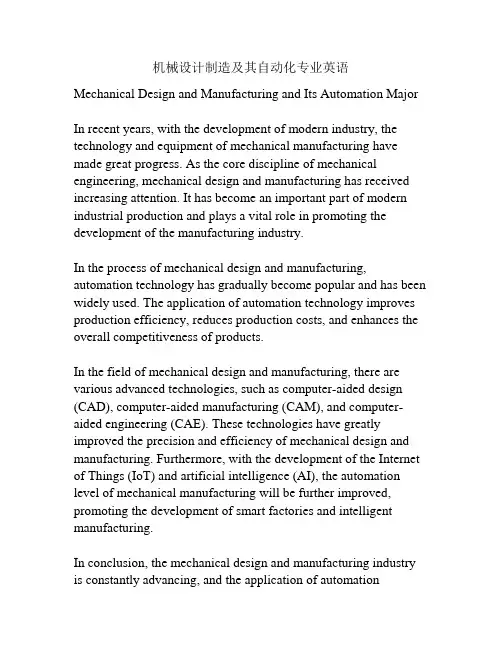
机械设计制造及其自动化专业英语Mechanical Design and Manufacturing and Its Automation MajorIn recent years, with the development of modern industry, the technology and equipment of mechanical manufacturing have made great progress. As the core discipline of mechanical engineering, mechanical design and manufacturing has received increasing attention. It has become an important part of modern industrial production and plays a vital role in promoting the development of the manufacturing industry.In the process of mechanical design and manufacturing, automation technology has gradually become popular and has been widely used. The application of automation technology improves production efficiency, reduces production costs, and enhances the overall competitiveness of products.In the field of mechanical design and manufacturing, there are various advanced technologies, such as computer-aided design (CAD), computer-aided manufacturing (CAM), and computer-aided engineering (CAE). These technologies have greatly improved the precision and efficiency of mechanical design and manufacturing. Furthermore, with the development of the Internet of Things (IoT) and artificial intelligence (AI), the automation level of mechanical manufacturing will be further improved, promoting the development of smart factories and intelligent manufacturing.In conclusion, the mechanical design and manufacturing industry is constantly advancing, and the application of automationtechnology is becoming increasingly important. As a result, the demand for professionals in this field is also growing. Students majoring in mechanical design and manufacturing and its automation should keep abreast of the latest developments and continuously improve their professional skills to meet the needs of the industry.当今,机械设计制造及其自动化专业的毕业生具有广阔的就业前景。
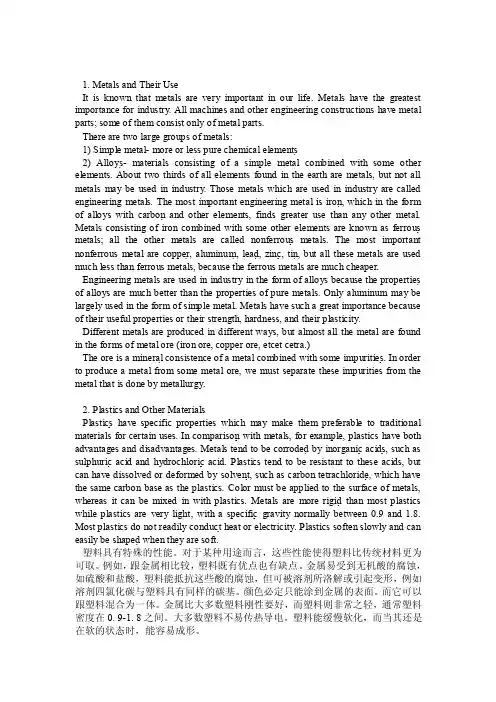
1. Metals and Their UseIt is known that metals are very important in our life. Metals have the greatest importance for industry. All machines and other en gineering constructions have metal parts; some of them consist only of metal parts.There are two large groups of metals:1) Simple metal- more or less pure chemical elements2) Alloys -materials consisting of a simple metal combined with some other elements. About two thirds of all elements found in the earth are metals, but not all metals may be used in industry. Those metals which are used in industry are called engineering metals. The most important engineering metal is iron , which in the form of alloys with carbon and other elements, finds greater use than any other metal. Metals consisting of iron combined with some other elements are known as ferrous metals; all the other metals are called nonferrous metals. The most important nonferrous metal are copper , aluminum ,lead ,zinc ,tin , but all these metals are used much less than ferrous metals, because the ferrous metals are much cheaper. Engineering metals are used in industry in the form of alloys because the properties of alloys are much better than the properties of pure metals. Only aluminum may be largely used in the form of simple metal. Metals have such a great importance because of their useful properties or their strength, hardness, and their plasticity .Different metals are produced in different ways, but almost all the metal are found in the forms of metal ore (iron ore, copper ore, etcet cetra.)The ore is a mineral consistence of a metal combined with some impurities . In order to produce a metal from some metal ore, we must separate these impurities from the metal that is done by metallurgy .2. Plastics and Other MaterialsPlastics have specific properties which may make them preferable to traditional materials for certain uses. In comparison with metals, for example, plastics have both advantages and disadvantages. Metals tend to be corroded by inorganic acids , such as sulphuric acid and hydrochloric acid. Plastics tend to be resistant to these acids, but can have dissolved or deformed by solvent , such as carbon tetrachloride , which have the same carbon base as the plastics. Color must be applied to the surface of metals, whereas it can be mixed in with plastics. Metals are more rigid than most plastics while plastics are very light, with a specific gravity normally between 0.9 and 1.8. Most plastics do not readily conduct heat or electricity . Plastics soften slowly and can easily be shaped when they are soft.塑料具有特殊的性能。
机械专业英语1. Introduction机械工程是一门涉及机械设备和工具设计、制造、使用和维护的学科,是工程技术领域中的一个重要分支。
机械专业英语是机械工程学习中必不可少的一部分,它涉及到机械工程师需要掌握的英语词汇、专业术语、文档阅读和撰写技巧等方面。
本文将介绍一些常用的机械专业英语词汇和常用的表达方式,以帮助读者更好地掌握机械专业英语。
2. Mechanical Engineering Vocabulary以下是一些常用的机械工程专业词汇,可以帮助读者对机械工程领域的基本概念有更好的了解:•Mechanical Engineering(机械工程): A discipline of engineering that deals with the design, construction, and operation of machinery.•Engineer(工程师): A person who designs, builds, or maintains engines, machines, or public works.•CAD(计算机辅助设计): Computer-Aided Design, a software tool used by engineers to create and modifymechanical designs.•CAM(计算机辅助制造): Computer-Aided Manufacturing, a software tool used to controlmanufacturing processes.•CNC(计算机数控): Computer Numerical Control,a method of controlling manufacturing machines usingcomputers.3. Common Expressions in Mechanical Engineering在机械工程领域,有一些常用的表达方式,以下是一些示例:•According to the design specifications(根据设计规范): Indicates that something is done in accordance with the design requirements.•The machine is in operation(机器正在运行): Indicates that the machine is currently running andperforming its intended function.•The material is heat-treated(材料经过热处理): Indicates that the material has undergone a specific heat treatment process for improved properties.•The system is experiencing mechanical failure(系统发生机械故障): Indicates that the system is notfunctioning properly due to a mechanical issue.•The component needs to be lubricated regularly(零部件需要定期加润滑油): Indicates that regularlubrication is required to ensure proper functioning of the component.4. Reading and Writing Documents in Mechanical Engineering在机械工程领域,阅读和撰写文档是非常重要的技能。
AC=alternative current交流AGV=Automated Guided Vehicle自动导引小车AGVS= Automated Guided Vehicle System自动导引小车系统AMT=advanced manufacturing technology先进制造技术ANSI=American National Standards Institute美国国家标准协会APT=Automatically Programmed Tools自动数控程序BOM=Bill of Material物料清单CAA=Computer Aided Analysis Process计算机辅助分析过程CAD=Computer-Aided Design计算机辅助设计CADD=Computer-Aided Design Drafting计算机辅助设计制图CAE=computer aided engineering计算机辅助工程CAM=Computer-Aided Manufacturing计算机辅助制造CAIT=computer aided testing and inspection计算机辅助实验与检测CAPP=Computer Aided Process Planning计算机辅助工艺设计CHP=chemical Polishing 化学抛光CIM=Computer integrated manufacturing计算机集成制造CBN=Cubic Boron Nitride立方氮化硼CMM=Coordinate Measuring Machine三坐标测量机CNC=computer numerical control电脑数字控制DC=direct current直流DNC=Direct Numerical Control直接数字控制DOF=degrees of freedom自由度DXF=data exchange format数据交换格式ECM=Electrochemical Machining电解加工EBM=Electron beam machining电子束加工EDM=Electrical Discharge Machining电火花加工EGM= enhanced graphics module增强型图形模组FA=factory automation工厂自动化FDM=Fused Deposition Modelling熔融沉积成型FEA=Finite element analysis有限元分析FMC=flexible manufacturing component柔性制造单元FMS=Flexible Manufacturing System柔性制造系统Finite-element有限元Four-bar linkage四连杆机构GNC=graphical numerical control图形数控GT=Grease Trap润滑脂分离器HPM=hard-part machining硬态切削HSS=High-Speed-Steel高速钢IGES=initial graphic exchange specification初始图形交换规则ISO=International Standardization Organization国际标准组织IT=International Tolerance(grade)国际公差JIT=Just in Time准时生产LBM=Laser beam machining激光切削加工LED=light-emitting diode发光二级管LMC=least material condition最小实体状态LOM=Laminated Object Manufacturing叠层实体制造技术MMC=maximum material condition最大实体状态MATL=material材料MC=machining center加工中心NC=Numerical Control数字控制NMP=Nontraditional Manufacturing Processes特种加工技术PCB=printed circuit boards印刷电路板PLC=Programmable Logic Controller PLC控制PKW=parallel kinematics machine并联机床QTY=quantity required需求数量RGV=rail guided vehicle有轨自动导引小车RPM=Rapid Prototype Manufacturing快速成型技术SL= Stereo Lithography光固化成型SLA=Stereo Lithography Apparatus立体印刷技术/光固化立体造型SLS=Selective Laser Sintering选择性激光烧结USM=Ultrasonic Machining超声波加工VNC=voice numerical control声音控制WEDM=Wirecut Electrical Discharge Machining电火花线切割加工WJM/C=water-jet machining/cutting水射流切削3D PRINT 3D打印一、将下列单词译成汉语Mechanism(机械,机构,机构学)configuration(外形,构造,结构)displacement(位移)velocity(速度)acceleration(加速度)gear(齿轮)sprocket(链轮)pulley(带轮)kinematician /dynamics(运动/动力学,力学)kinematician(运动)cam凸轮camshaft凸轮轴accuracy精度dependability可靠性pulley滑轮flywheel飞轮crank曲柄sprocket链轮axle心轴spindle主轴clutche离合器brake制动shaper牛头刨床planer龙门刨pulley皮带轮flywheel飞轮spindle轴clutche离合器crank曲柄sprocket链轮axle车轴brake制动warpage配气机构coolant冷却剂二、将下列词组译成汉语kinematic chain(运动链)skeleton diagram(草图,示意图,简图)Gear system/Cam system(齿轮传动系统/凸轮系统)uniform motion/nonuniform motion(匀速运动/非匀速运动)nonlinear motion(非线性运动)kinematic analysis(运动分析)schematic diagram(运动简图)textile machinery(纺织机械)Kinematic design/ kinematic syntheses(运动设计/运动合成)machinedesign(机械设计)Gear trains/ Cam mechanisms(轮系,齿轮传动链/凸轮机构)dynamic force/inertia force/ static force(动力/惯性力/静力)relative velocity/ absolute velocity(相对速度/绝对速度)angular acceleration/ tangential acceleration/ centripetalacceleration/ velocity vector(角加速度/切向加速度/向心加速度/速度矢量)binary link/ ternary link(二杆组/三杆组)the basecircle(基圆)the pitch curve(啮合曲线)the contact force(接触力)the intermittent motion (间歇运动)the common normal(公法线)the conjugate profiles(共轭齿廓)the cycloidal profiles (摆线齿形)the involute profiles (渐开线齿形)the spurgear(直齿轮)the herringbone gears(双螺旋齿轮)the face gear(端面齿轮)the radial distance (径向距离)the addendumcircle(齿顶圆)The tooth thickness(齿厚)the tooth space(齿间隙)the cap screws(螺钉)the setscrews(固定螺丝钉)theengineering graphics(工程力学)mechanical design(机械设计)the installation techniques(安装技术)the bolted joint(螺栓连接)the hardened washers(强化垫圈)the fatigue resistance(抗疲劳强度)the modulus of elasticity(弹性模量)theantifriction bearing(减摩轴承)the rolling bearing(滚动轴承)the rolling contact (滚动接触)the sliding contact(滑动触电)the corrosion resistance(抗腐蚀性)the machining tolerances(加工公差)the fatigue loading (疲劳载荷)the radial loads(径向负荷)the thrust loads逆负荷the ball bearing球轴承the roller bearing滚子轴承the single-row bearings单沟轴承thedouble-row bearing双沟轴承the needle bearing滚针轴承the bearing life轴承寿命The rating life额定寿命the axis of rotation旋转轴The helix angle螺旋角a right-hand helix 右旋a left-hand helix左旋an involute helicoids螺旋面an involute curve渐开线theshaft centerlines轴中心线worm gear蜗轮the hypoid gear准双曲面齿轮right angle直角worm gearing蜗杆传动the lead angle导角shaftangle轴线角度bending load弯曲载荷tension load张力负荷compression load压缩负载torsional load扭转负荷the bending moment弯矩the bending stress弯曲应力the shot peening喷丸法the actuating force工作力the coefficient of friction摩擦系数Anelectromagnetic coil电磁线圈the magnetic circuit磁路the design specifications中国设计规范the industrial engineering工业工程the machining industry加工行业the machine shops机器商店machine tool机床angular displacements角位移The electric motor电机transmission Linkage传输连接the cutting force切削力the static loads静态负荷the dynamic loads动态载荷the grinding wheel砂轮lubricating oil润滑油the cutting fluids切削液protective guards防护装置the cutting tool刀具the range of feeds进给量enginelathes普通车床turret lathes六角车床the boring machine镗床the drilling machines钻床the milling machines铣床the broachingmachines绞孔机;拉床the sawing machines锯床the cylindrical grinder外圆磨床the centreless grinders无心磨床the surface grinders平面磨床the chemical milling铣削the ultrasonic machining超声波加工a toolholder刀架a compound rest复式刀架the feed screw丝杆the feed rod光杆The feed box进给箱power feed进给the full depth大切削深度thread cutting螺纹切削a chasing dial螺纹指示盘the forward stroke冲程the return stroke回程the clapper box摆动刀架thehydraulic shaper液压牛头刨床the universal machines通用机械universal joints万向节Tracer milling仿形铣the master pattern模型the acceleration of gravity重力加速度conducting material导电材料non-conducting material绝缘材料三、将下列短语译成汉语1.Plane and spatial linkages(平面和空间连杆)2.constrained kinematic chain/unconstrained kinematic chain(约束运动链/非约束运动链)3.closed-loop linkage(闭环运动链)4.four-bar linkage(四连杆机构)5.slider-crank (or crank and slider) mechanism(曲柄滑块机构)6.internal combustion engine(内燃机)7.the kinematic analysis of mechanisms(机构运动分析)8.degree of freedom of the mechanism(机构自由度)9.kinematic analysis process /kinematic synthesis process(运动分析步骤/运动合成步骤)10.input angular velocity(输入角速度)11.input angular acceleration(输入角加速度)12.automatic packaging machinery(自动包装机)13.cam-contour dimensions/cam-follower diameters(凸轮轮廓尺寸/凸轮从动件直径)14.mechanical analog computer(机构模拟计算机)15.dead-center position(死点位置)16.crank-rocker linkage/double-rocker linkage/double-crank (drag-link) linkage(曲柄摇杆机构/双摇杆机构/双曲柄机构)17.maximum force component/ resulting output force or torque(最大的力量组成/输出的最大力或力矩)18.output motion variables/input motion variable(输出运动变量/输入运动变量)19.absolute angular positions(绝对角位置)20.velocity polygon method(速度的多边形的方法)21.instantaneous center method/instant center method(瞬心法/即时瞬心法)22.inertia-force analysis of mechanisms and machines(机构和机器的惯性力分析)23.one and the same coordinate system /inertia frame of reference(惯性参考系)24.systematic design of mechanisms(机械设计的系统)25.cam-contour dimensions/cam-follower diameters(凸轮轮廓尺寸/凸轮从动件直径)26.disk or plate translating (two-dimensional or planar) 盘形传动凸轮(两维的,即平面的)27.cylindrical (three-dimensional or spatial) cams圆柱形凸轮(三维的,即空间的)机构28.a radial (in-line) translating roller follower一个对心直动滚子从动件29.a constant angular velocity ratio旋转角速度的比例30.a constant torque ratio一个恒转矩比31.Nonlinear angular velocity ratios非线性角速度比率32.the parallel helical gear平行斜齿轮33.the crossed helical gear交叉斜齿轮34.the straight bevel gear直锥齿轮35.the spiral bevel gear弧齿锥齿轮36.the skew bevel gear大角度斜交锥齿轮37.the hexagon head screws六角头螺钉38.the fillister head screws槽头螺钉39.the flat head screws 平头螺钉40.the hexagon socket head screws内六角沉头螺钉。
【The branch of scientific analysis which deals with motions time and forces is called mechanics and is made up of two parts statics and dynamics】. 对运动、时间和作用力进行科学分析的分支称为力学,它由静力学和动力学俩部分组成。
【Statics deals with the analysis of Stationary ,i .e.,those in which time is not a factor,and dynamics deals with systems which change with time 静力学对静止系统进行分析,即在其中不考虑时间这个因素,动力学对随时间而变化的系统进行分析。
【Forces are transmitted into machine members through matingsurfaces ,e.g.,form a gear to a shaft or form one gear through meshing teeth to another gear,from a V belt to a pulley,or from a cam to a follower】.力通过接触表面传到机器中的各构件上。
例如,从齿轮传到轴或者从齿轮通过与其啮合的轮齿传到另一个齿轮,从V带传到带轮,或者从凸轮传到从动件。
【It is necessary to know the magnitudes of these forces for a variety of Reasons】由于很多原因,人们必须知道这些力的大小。
【The distribution of the forces at the boundaries or mating surfaces must be reasonable and their intensities must be within the working limits of the materials composing thesurfaces】这些力在边界或在接触表面的分布必须合理,它们的大小必须在构成配合表面的材料的工作极限以内。
机电工程专业英语第二版课后答案lesson41、Ships can carry more goods than _____ means of transport. [单选题] *A. the otherB. anotherC. any other(正确答案)D. any2、We have ______ homework today. ()[单选题] *A. too manyB. too much(正确答案)C. much tooD. very much3、July hardly joins in any class activities,_____? [单选题] *A. does she(正确答案)B. doesn't sheC. didn't sheD. is she4、There are many_____desks in the room. [单选题] *rge old brown(正确答案)B.old large brownrge brown oldD.brown old large5、I like booking tickets online,because it is _______. [单选题] *A. boringB. confidentC. convenient(正确答案)D. expensive6、We should _______ a hotel before we travel. [单选题] *A. book(正确答案)B. liveC. stayD. have7、Before leaving the village, he visited the old house _____ he spent his childhood. [单选题] *A in which(正确答案)C. to whichD at which8、She works in a hospital. She is a(n) _______. [单选题] *A. managerB. engineerC. doctor(正确答案)D. patient9、For the whole period of two months, there _____ no rain in this area. Now the crops are dead [单选题] *A. isB. wasC. has been(正确答案)D. have been10、There are sixty _______ in an hour. [单选题] *A. hoursB. daysC. minutes(正确答案)11、18.Monica wants to be a _______. She is good at sports and she loves teaching others. [单选题] *A.coach(正确答案)B.secretaryC.architectD.waiter12、Generally speaking, it is _______ to ask a woman’s age in western countries. [单选题] *A. possibleB. importantC. not polite(正确答案)D. polite13、David ______ at home when I called at seven o’clock yesterday evening. ()[单选题] *A. didn’tB. doesn’tC. wasn’t(正确答案)D. isn’t14、25.—I ______ Beijing for a holiday.—________. [单选题] *A.will go;GoodbyeB.will go;Have a good time(正确答案)C.will go to;Have a good timeD.am going to;Have a fun15、____ of my parents has been to my school, so they know _____ of my classmates. [单选题] *A. Neither, none(正确答案)B. No one, noneC. None, no oneD. Neither, no one16、It’s windy outside. _______ your jacket, Bob. [单选题] *A. Try onB. Put on(正确答案)C. Take offD. Wear17、A brown bear escaped from the zoo, which was a()to everyone in the town. [单选题] *A. HarmB. violenceC. hurtD. threat(正确答案)18、I run out of money. Could you _______ me some?[单选题] *A. lend(正确答案)B. sellC. borrowD. buy19、Mike and his friend are going to the _______ to see the new action movie tonight. [单选题] *A. book shopB. restaurantC. concertD. cinema(正确答案)20、67.—What can I do for you?—I'm looking at that dress.It looks nice.May I ________?[单选题] *A.hold it onB.try it on(正确答案)C.take it offD.get it off21、——Have you()your friend Bill recently? ———No, he doesnt often write to me. [单选题] *A. heard aboutB. heard ofC. heard from (正确答案)D. received from22、—Excuse me, how long does it ______ to walk to the library? —About 15 minutes, I’m afraid.()[单选题] *A. take(正确答案)B. spendC. costD. pay23、Finally he had to break his promise. [单选题] *A. 计划B. 花瓶C. 习惯D. 诺言(正确答案)24、—What’s the matter with that boy?—______.()[单选题] *A. He is watching TV in his roomB. He takes his temperatureC. He was playing a toy carD. He hurt his right leg(正确答案)25、99.—Would you please show me the way _________ the bank?—Yes, go straight ahead. It’s opposite a school. [单选题] *A.inB.forC.withD.to(正确答案)26、My watch usually _______ good time, but today it is five minutes fast. [单选题] *A. goesB. makesC. keeps(正确答案)D. gains27、—_____ will the bus arrive? —In four minutes. [单选题] *A. How longB. How oftenC. How soon(正确答案)D. How far28、I took?some _______of the Great Wall?in China last year. [单选题] *A. potatoesB. tomatoesC. photos(正确答案)D. paintings29、--Shall we have a swim?--Yes, let’s _______ it at 9:00 next Sunday. [单选题] *A. putB. meetC. setD. make(正确答案)30、_______ a busy afternoon! [单选题] *A. HowB. What(正确答案)C. WhichD. Wish。
1 / 32 专业英语翻译 —一 stressand strain (应力与应变)
1the fundamental concepts 基本概念 cross section 横截面 the internal stresses produced in the bar 杆的内应力 continuous distribution of hydrostatic pressure 流 体静压力 the tensile load 拉伸载荷 a uniform dis tribution over the cross section 在横截面均匀分布 arbitrary cross-sectional shape 任意截面形状 tensile stresses 拉应力 compressive stresses 压应力 a normal stress 正应力 through the centroid of the cross sectional area 通过横截面形心 the uniform stress condition 压力均匀分布 the stress distribution at the ends of the bar 杆末端应力分布 high localized stresses 高度应力集中 an axially loaded bar 轴向载荷杆件 a tensile strain 拉应变 an elongation or stretching of the material 材料 拉伸 a compressive strain 压应变 the ratio of two lengths 两 个长度的比值 purely statical and geometrical considerations 从 纯 静 态 以 及 几 何 角 度 考 虑 1.That branch of scientific analysis which motions, times and forces is called mechanics and is made up of two parts, statics and dynamics. 研究位移、 时间和力运动乘力是科学分析法的一个分支, 被称作力学, 力学由两大部分组成, 静力学和动力学。 2.For example, if the force operating on a sleeve bearing becomes 2 / 32
too high, it will squeeze out the oil film and cause metal-to-metal contact, overheating and rapid failure of the bearing. 例如:如果止推轴 承上的作用力过大的话,会挤出油膜,引起金属和金属之间 的相互接触, 轴承将过热而迅速失效。 3.Our intuitive concept of force includes such ideas as place of application, direction, and magnitude, and these are called the characteristics of a force. 力的直观概念包括力的作用点、大 小、方向,这些被称为力的三要素。 4.All bodies are either elastic or plastic and will be deformed if acted upon by forces. When the deformation of such bodies is small, they are frequently assumed to be rigid, i.e., incapable of deformation, in order to simplify the analysis. 所有的物体既可以是弹性的 也可以是塑性的, 如果受到力的作用就产生变形。 当变形 很小的 时候它们被假设成刚体,也就是不产生变形。 5.The rigid-body assumption cannot be used in internal stresses and strains due to the applied forces to be analyzed. Thus we consider the body to be capable of deforming. 刚体假设不能 应用于内应力和内应变的分析,所以在实际力的分析时,要 考虑物体的形变。 6.If all the forces acting on a particle are balanced, the particle will either remain at rest or will continue to move in a straight line at a uniform velocity. 如果作用在质点上所有的力是平衡的,质点将会保持静止或 做做匀速直线运动。 3 / 32
2 1) the main manifestations of capacity 主要的表现能力 2) the maximum unit load ( stress) 最大单位载荷(应力) 3) stress-strain diagram 应力—应变图 4) the simple tensile test 简单的拉伸试验 5)the percentage elongation at rupture 断裂伸长率 6) the ends of tensile specimens 拉伸试样的两 端 7 ) permanent deformation 永久变形 8) the resulting load-displacement curve 由此产生的载荷位移曲线 9 ) a substantial yielding of the material 大量产生的物质 10 )yield point 屈服点 11) the transition from elastic to plastic behavior 从弹性到塑性的过度 12 )material property table 材料属性表 13) plastic deformation 塑性变形 14)a specified standard length of the specimen 指定的标准式样长度 15) at the moment of rupture 此 刻 的 破 裂 16 ) short cylindrical specimens 短圆柱标本 17) ductile materials 韧性材料 18) high stress concentration 高应力集中 19) ultimate tensile strength 极限抗拉强度 20) strain hardening zone 应变硬化
区 1)A tensile test consists of slowly pulling a sample of material with a tensile load until it breaks. The ends of tensile specimens are usually enlarged to pr ovide extra area for gripping and to 4 / 32
avoid having the sample break where it is being gripped. 拉伸试验包括慢慢加载拉伸载荷直到断裂, 拉伸试 件两端加粗为了提供装夹区域和避免试件 断裂。 2) The usual manner of conducting the test is to deform the specimen at a constant speed .For example, in the Universal testing machines, the motion between the fixed and moving cross heads can be controlled at a constant speed. 通常进行试验的 方法就是使试件以恒定速度发生变形。 例如,在万能拉伸 试验机上,固定端和移动的十字滑块 之间的变形是以恒定 速度进行的。 3 )The load that must be applied to enforce this displacement rate varies as the test proceeds. This load F may be divided by the cross-sectional area A to obtain the stress in the specimen at any time during the test. 随着实验的进行, 用 来产生位移的载荷是随位移的变化而变 化。在实验中,载 荷 F 除以横截面积 A 可以得到任意时刻点的应力。 4 ) However actual measurement of △ L is preferable where This is feasible. Stress and strain based on the initial (undeformed) dimensions, Ai and Li, are called engineering Stress and strain. 然而,在可行的位置的厶 L的实际测量是更可取的, 基于原 始尺寸 Ai 和 Li 的应力和应变称 为工程应力和工程应变 5)Ductile and brittle materials behave differently in compression test as well. The compression test is conducted on short Cylindrical specimens placed between parallel plates. 塑 性和脆性